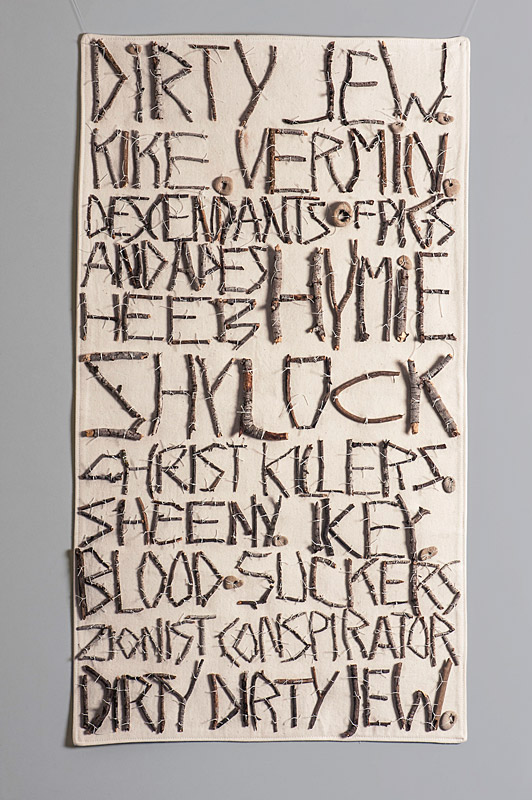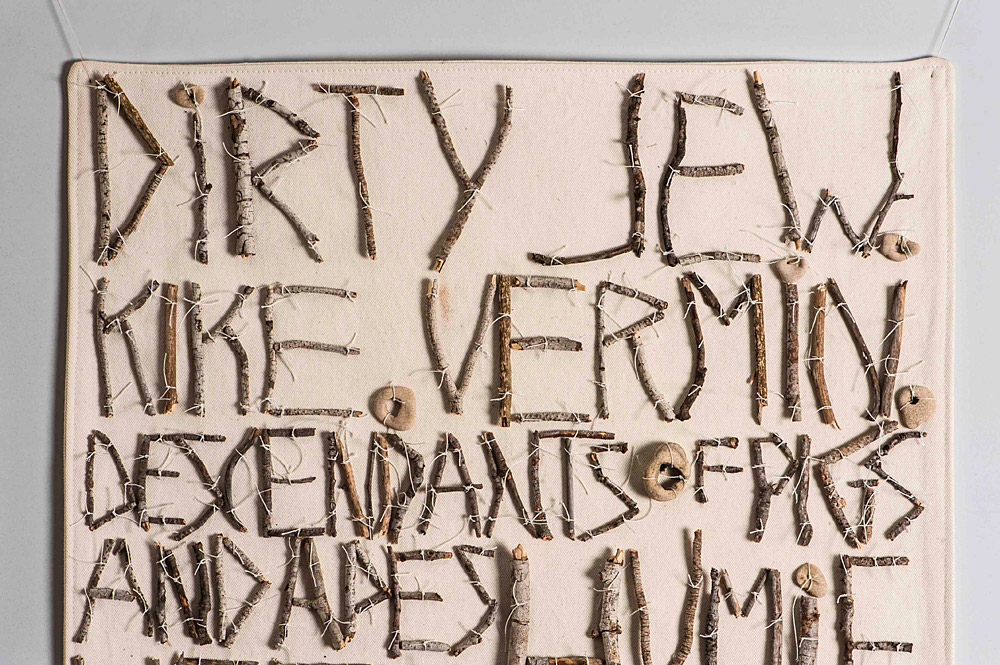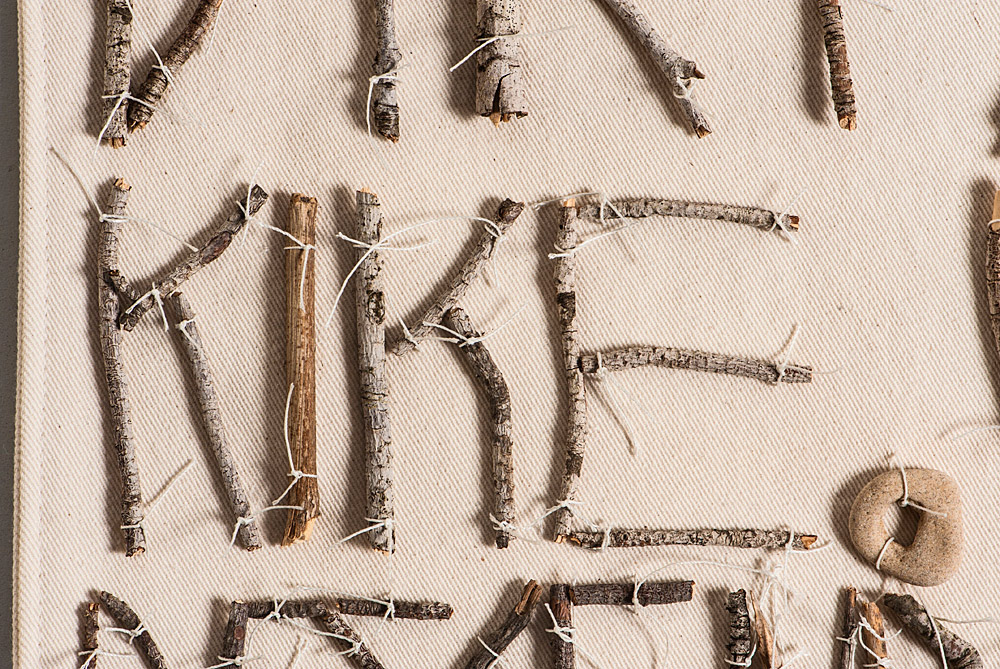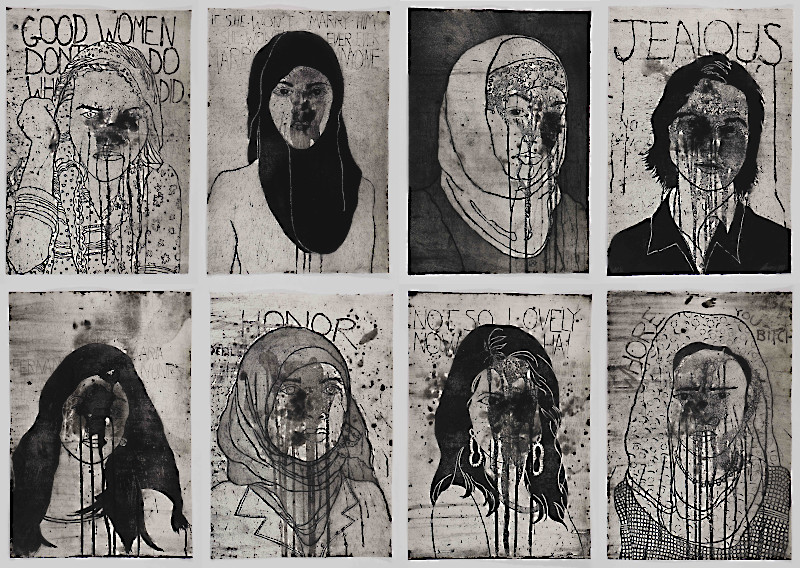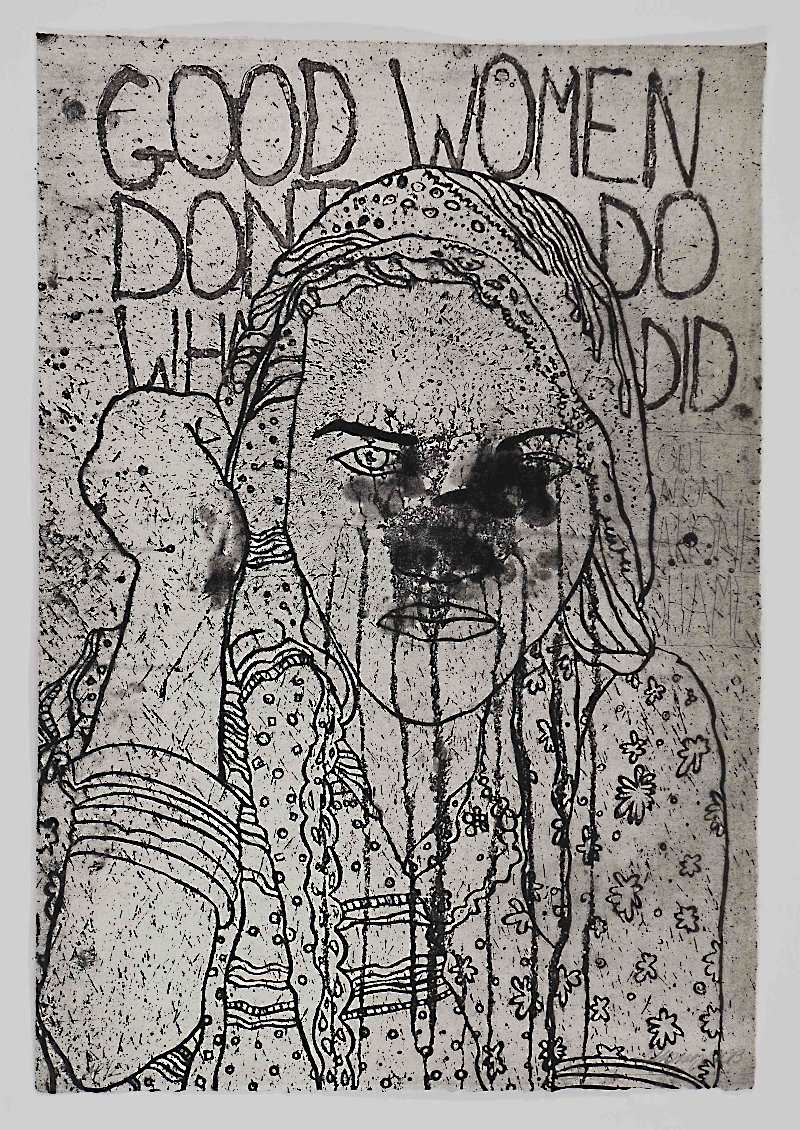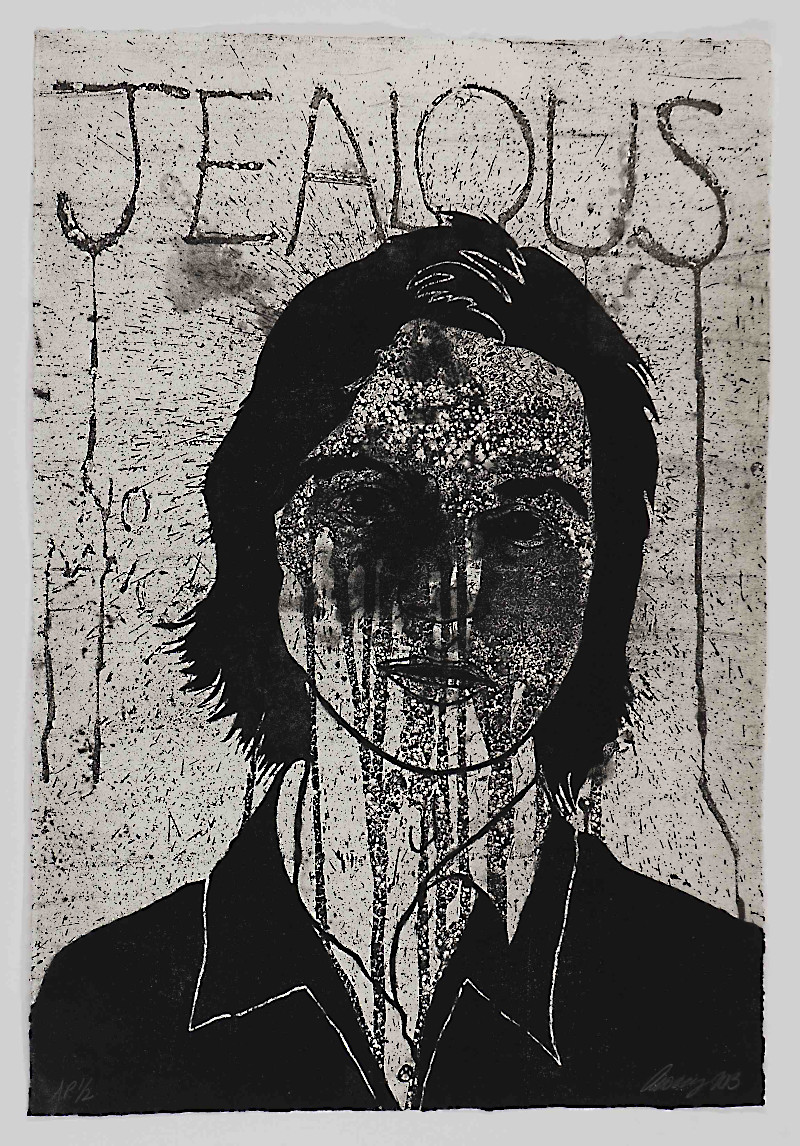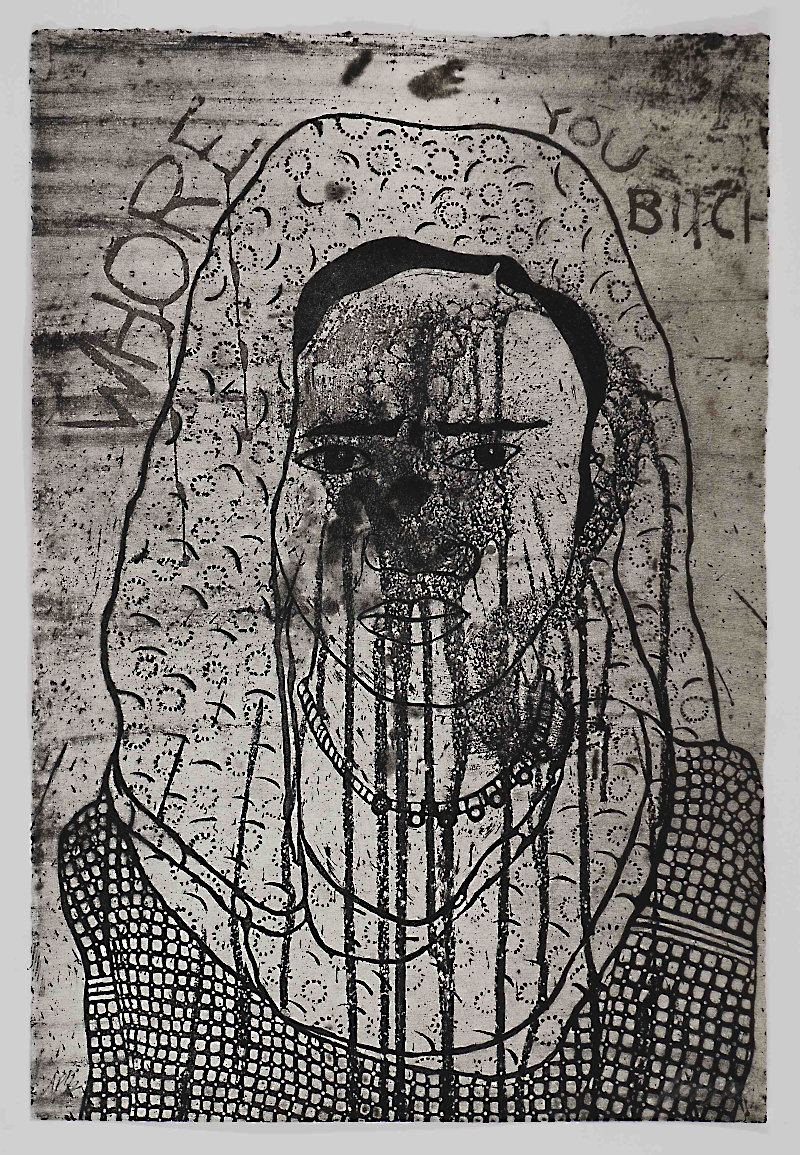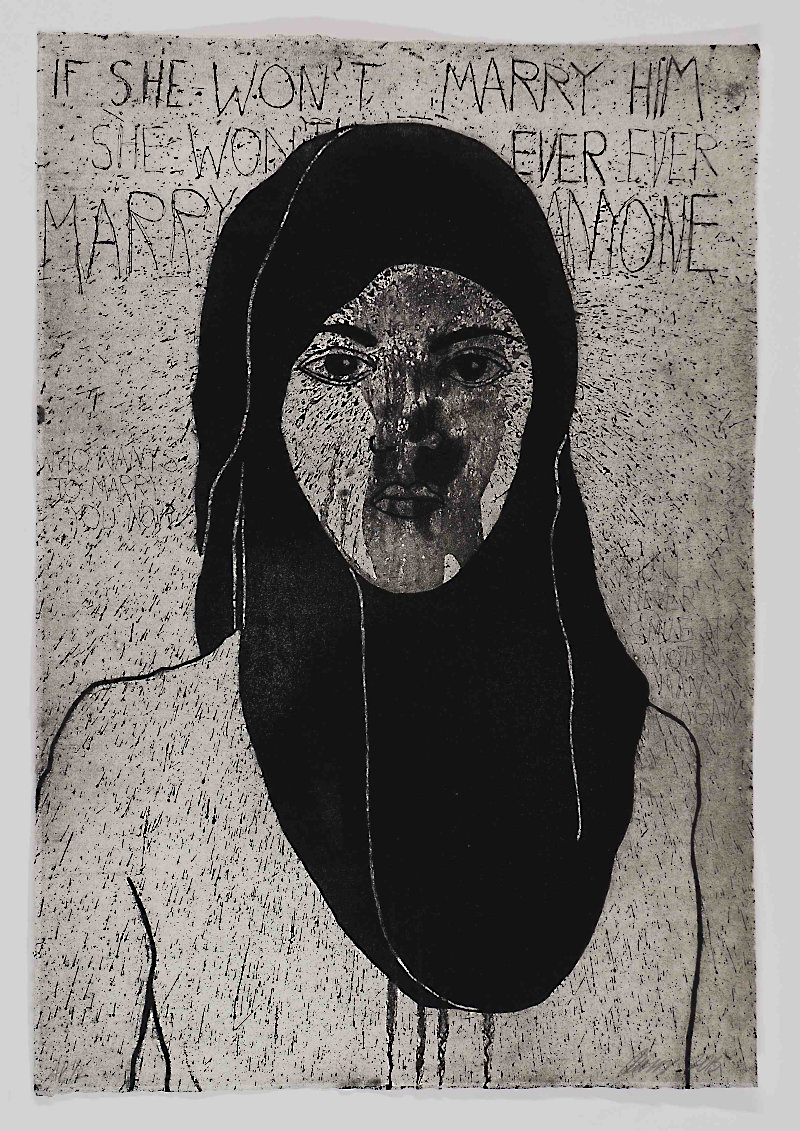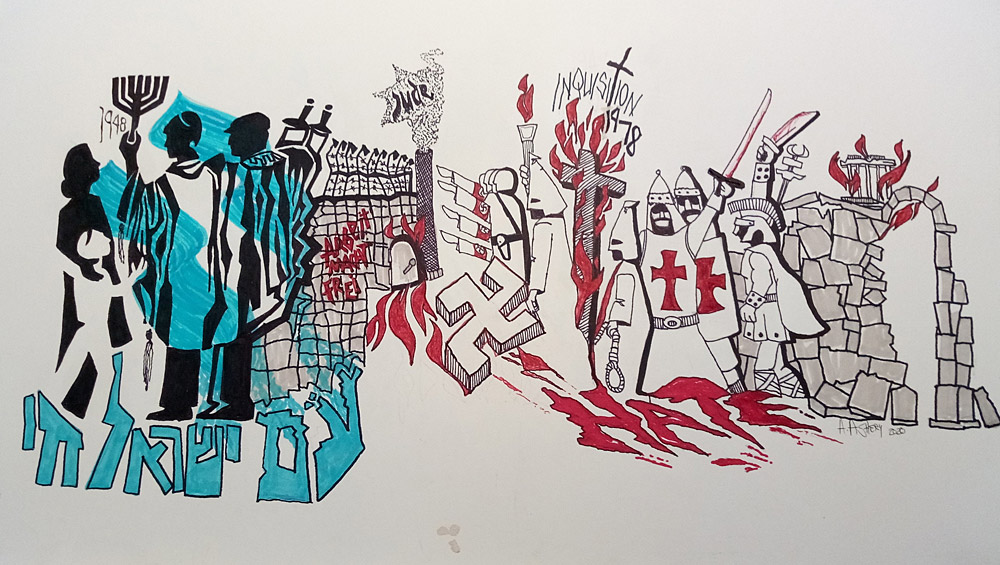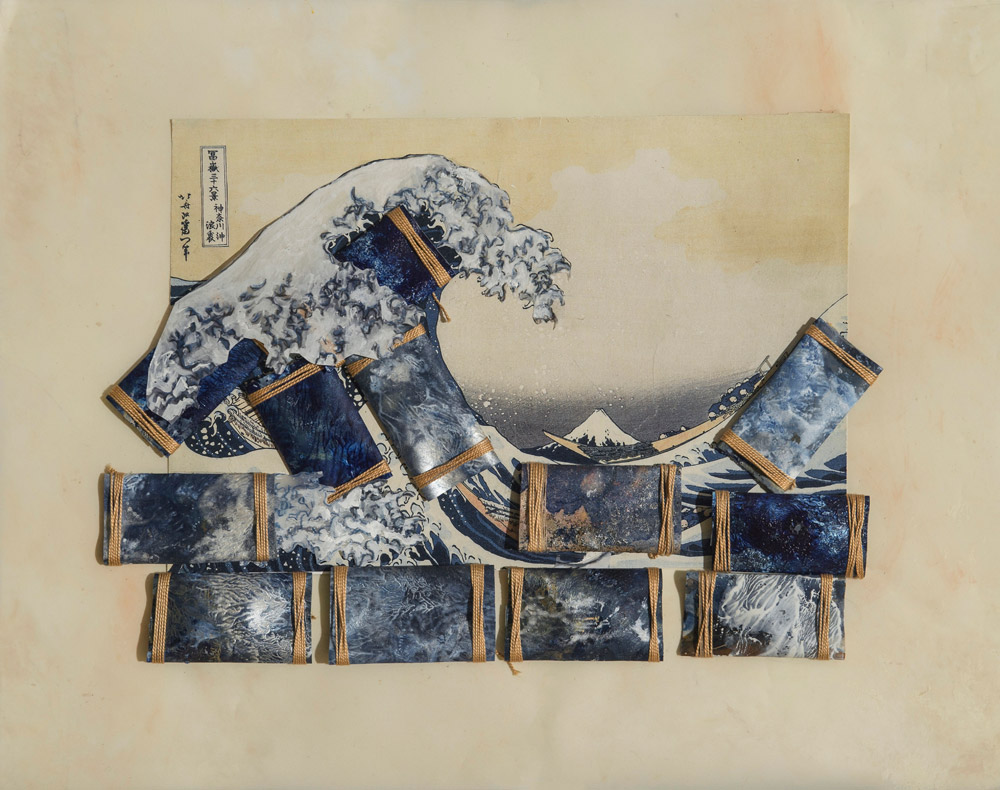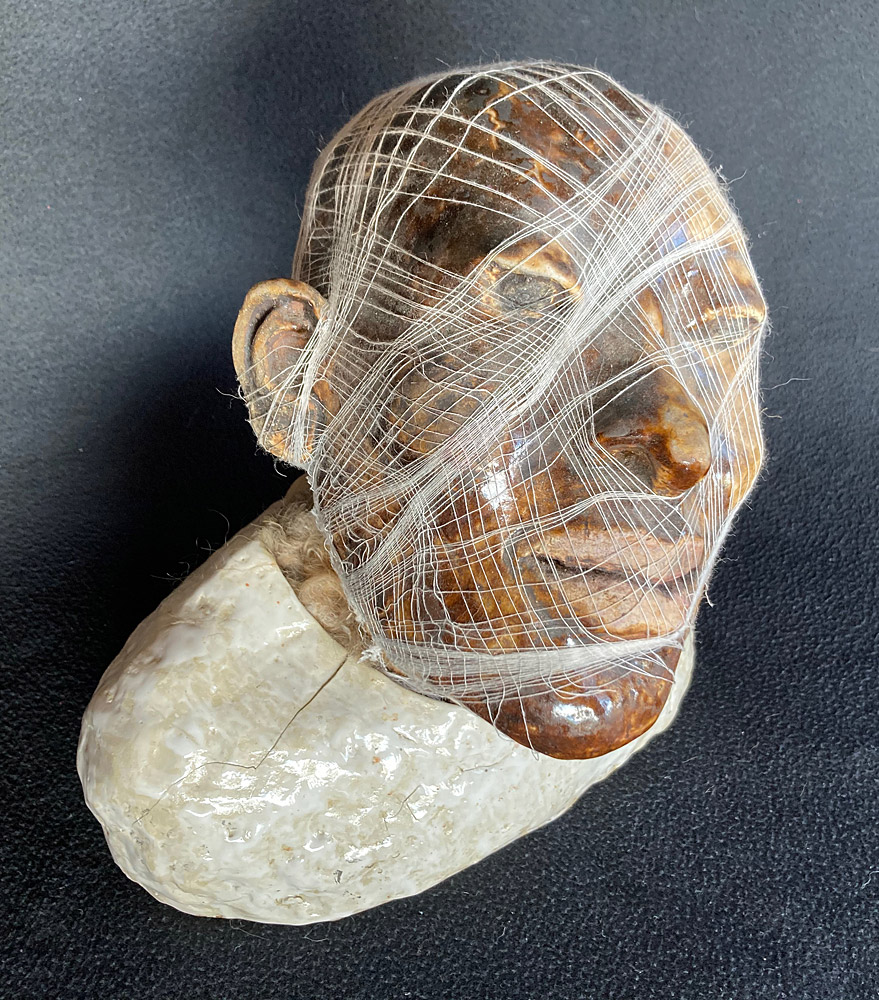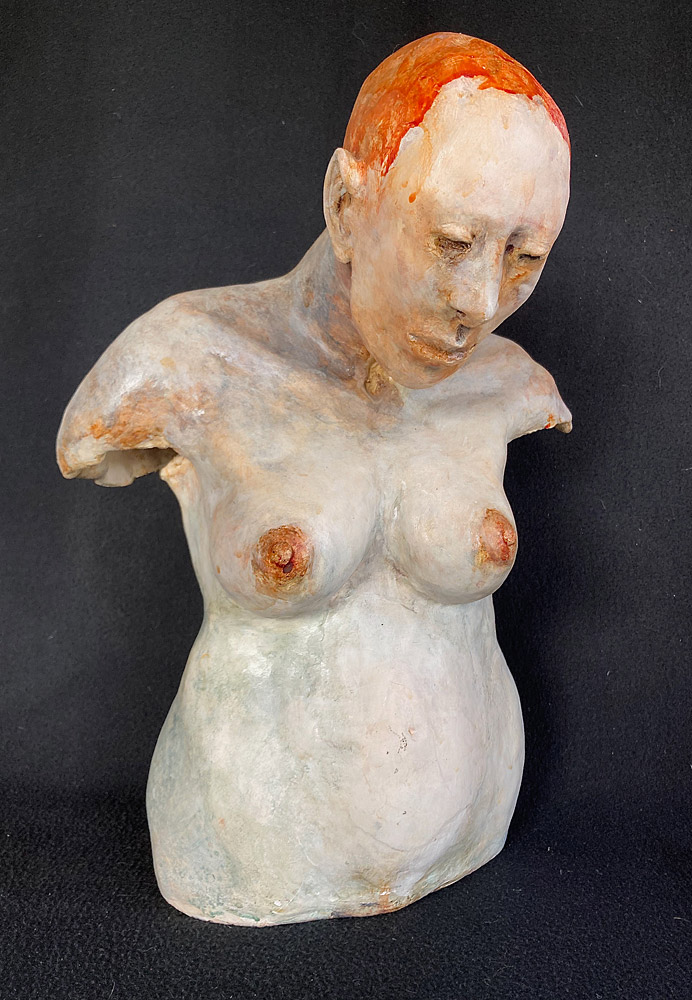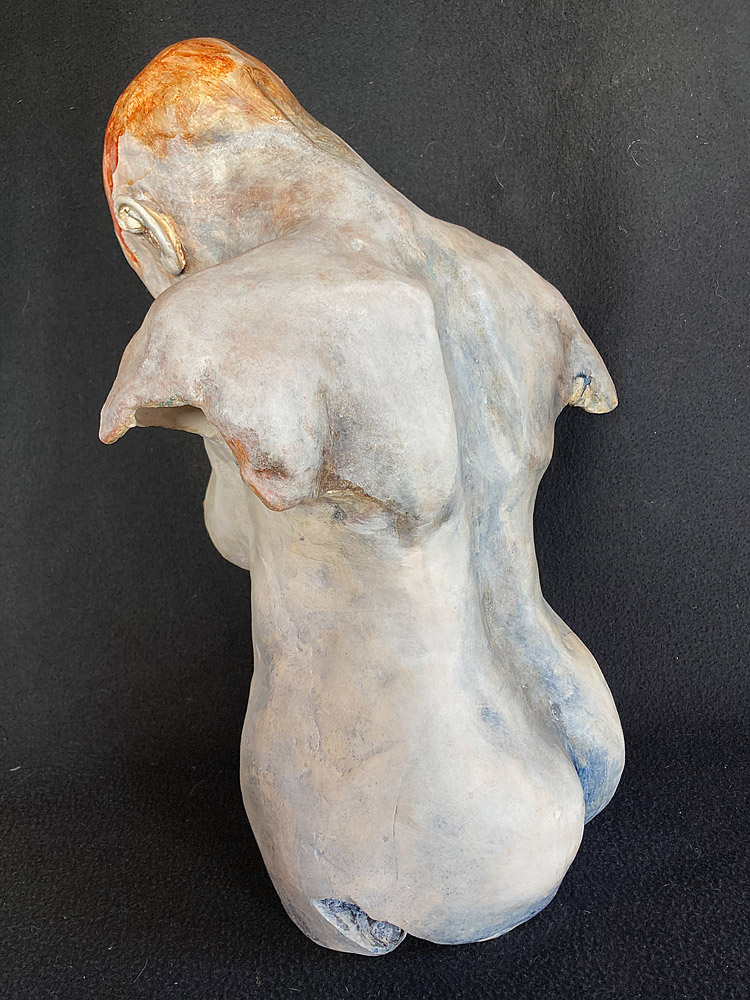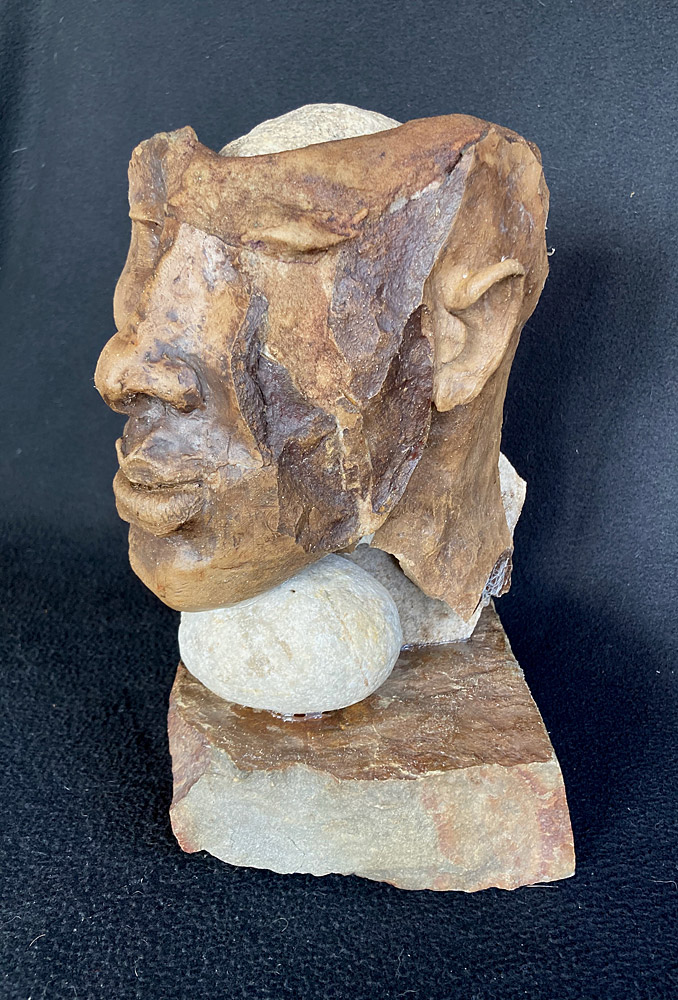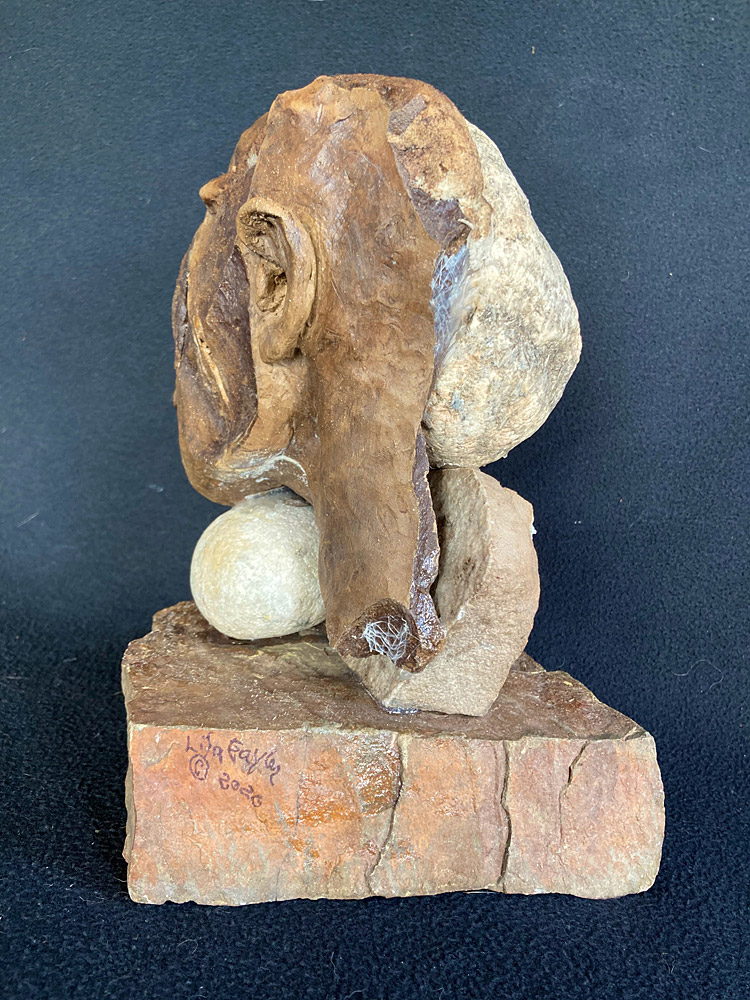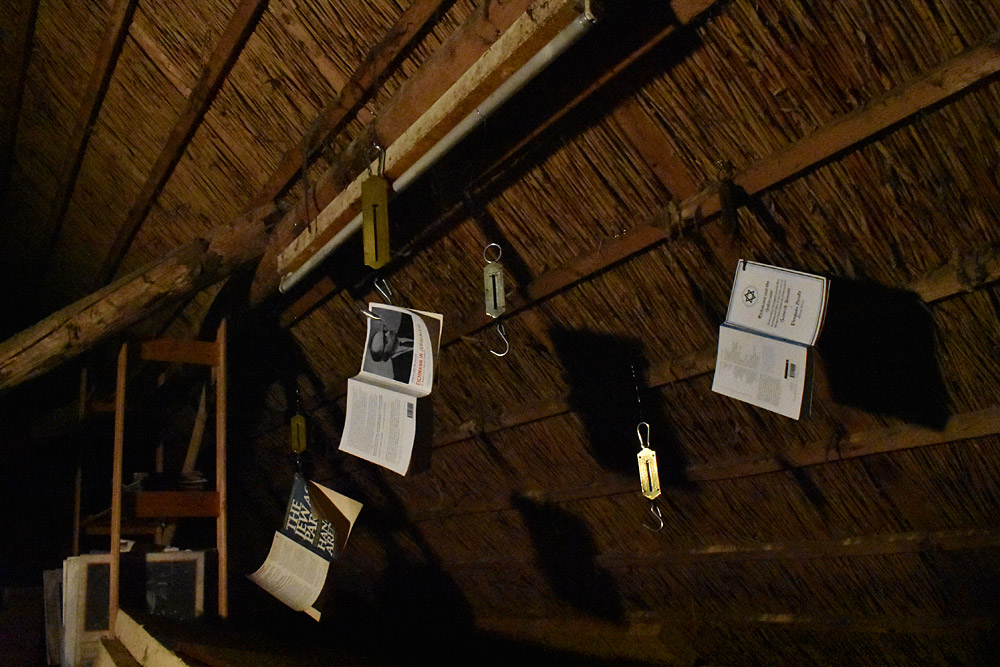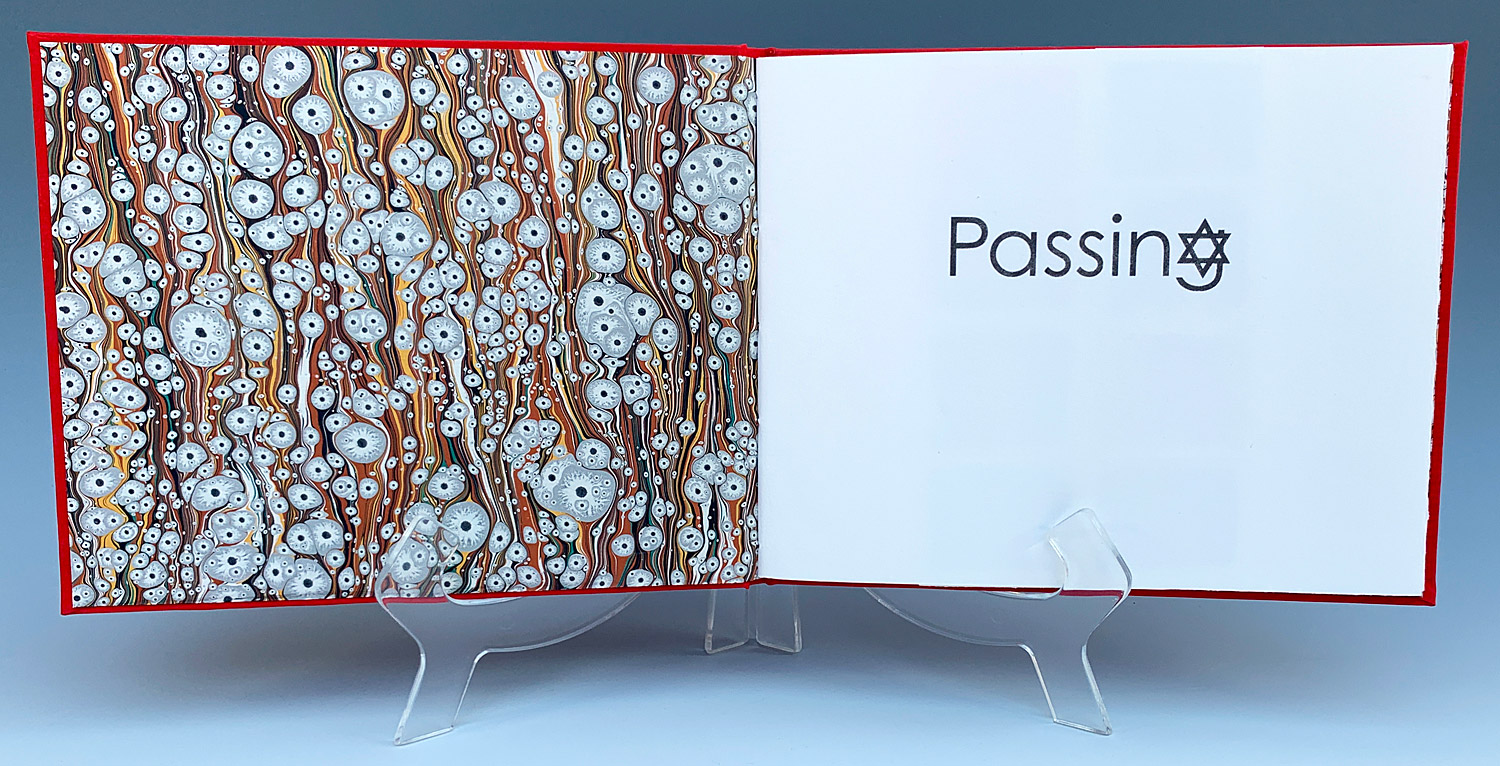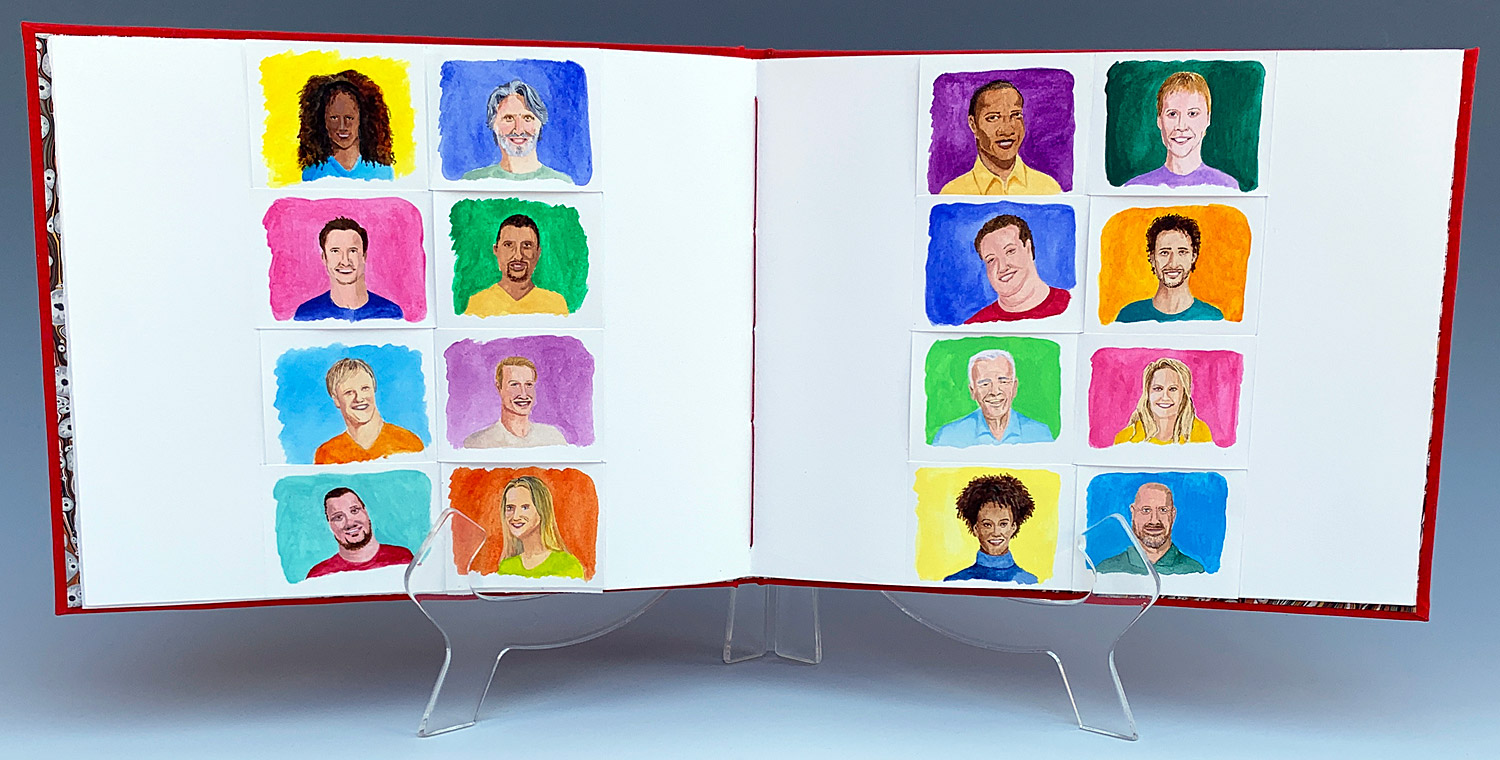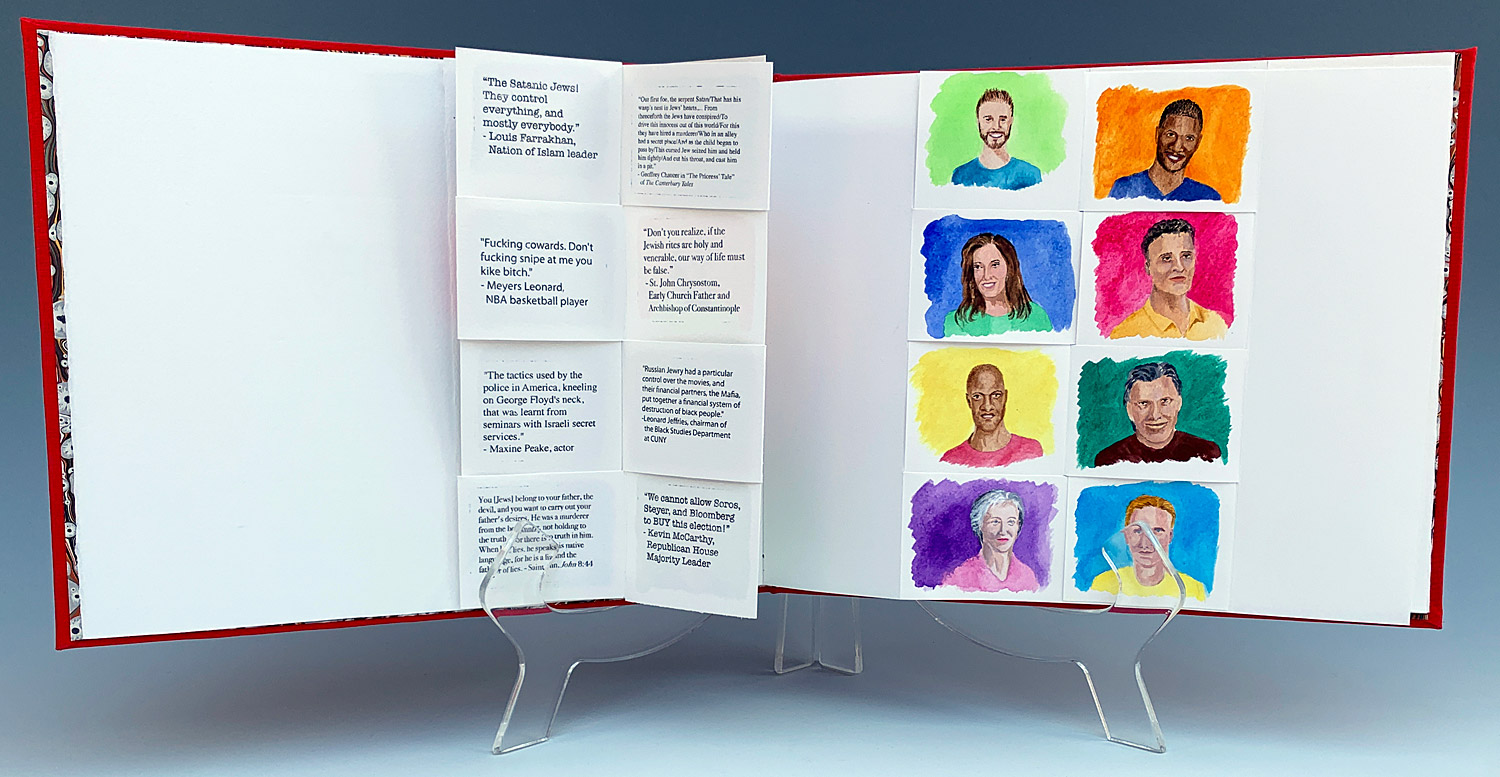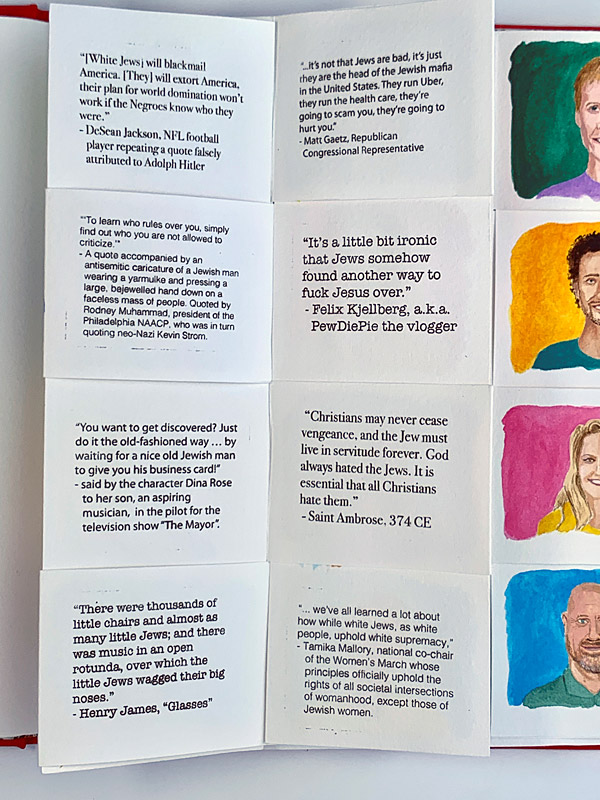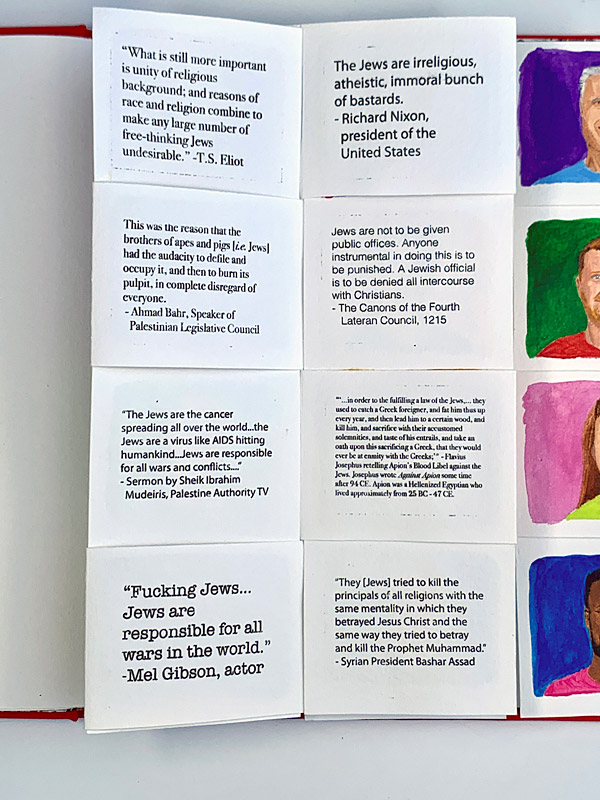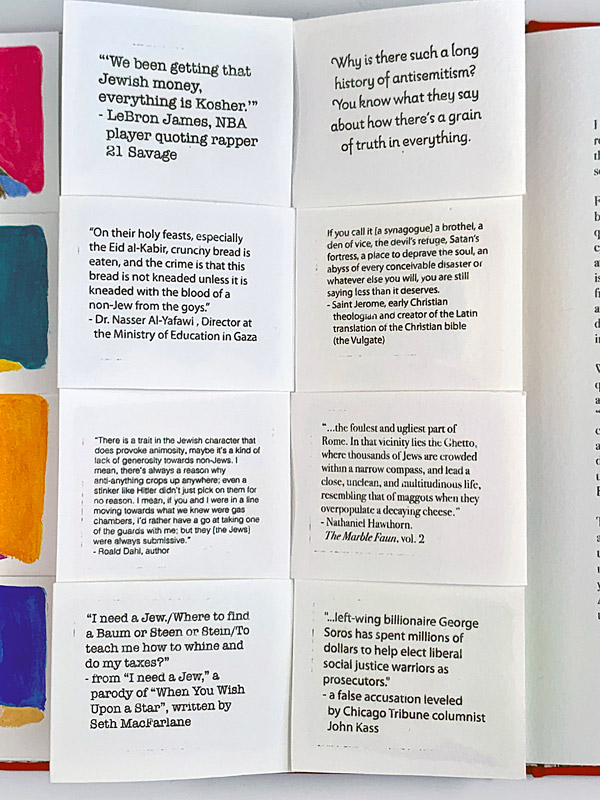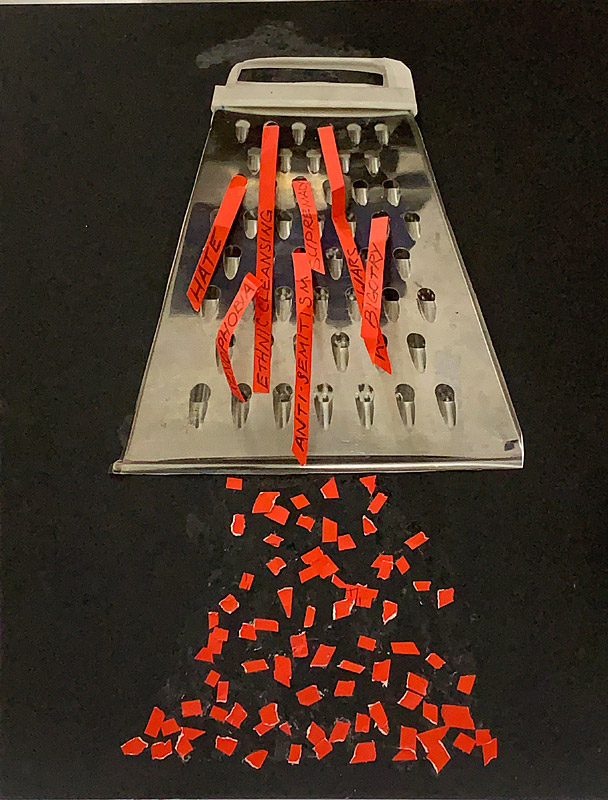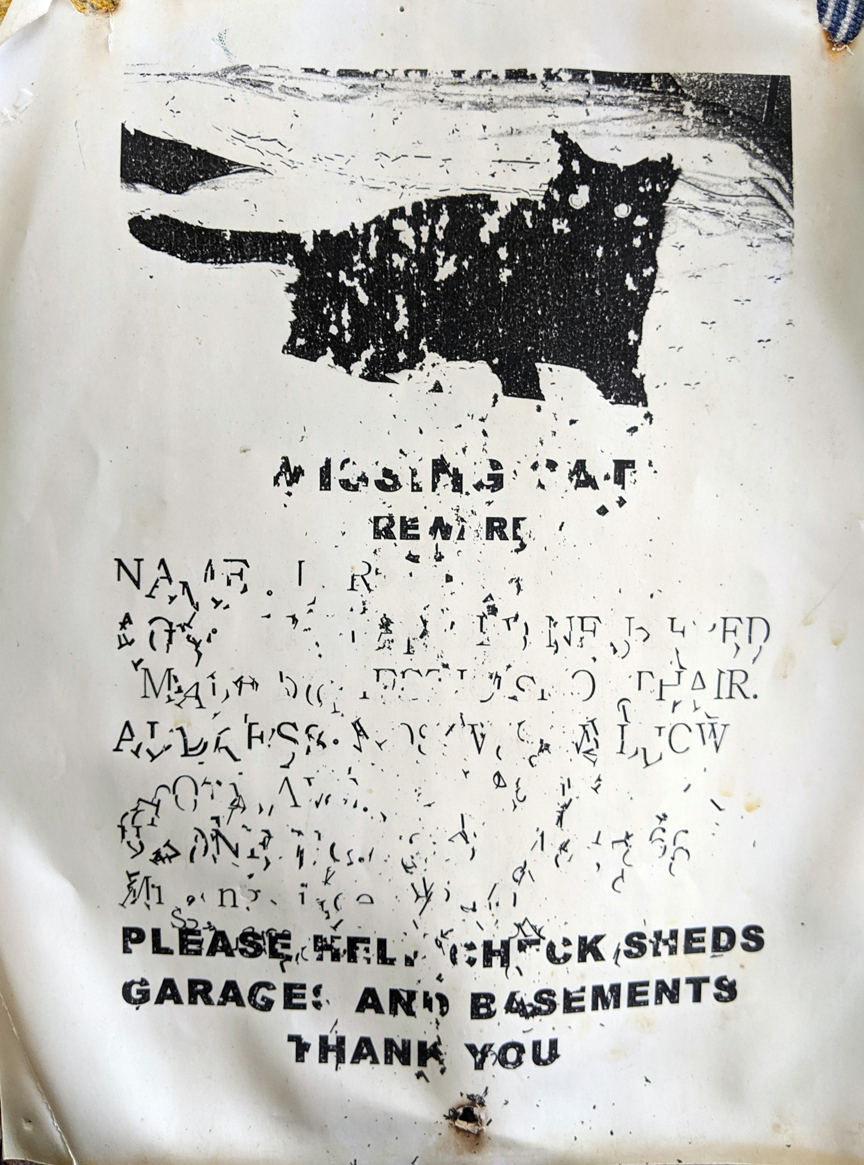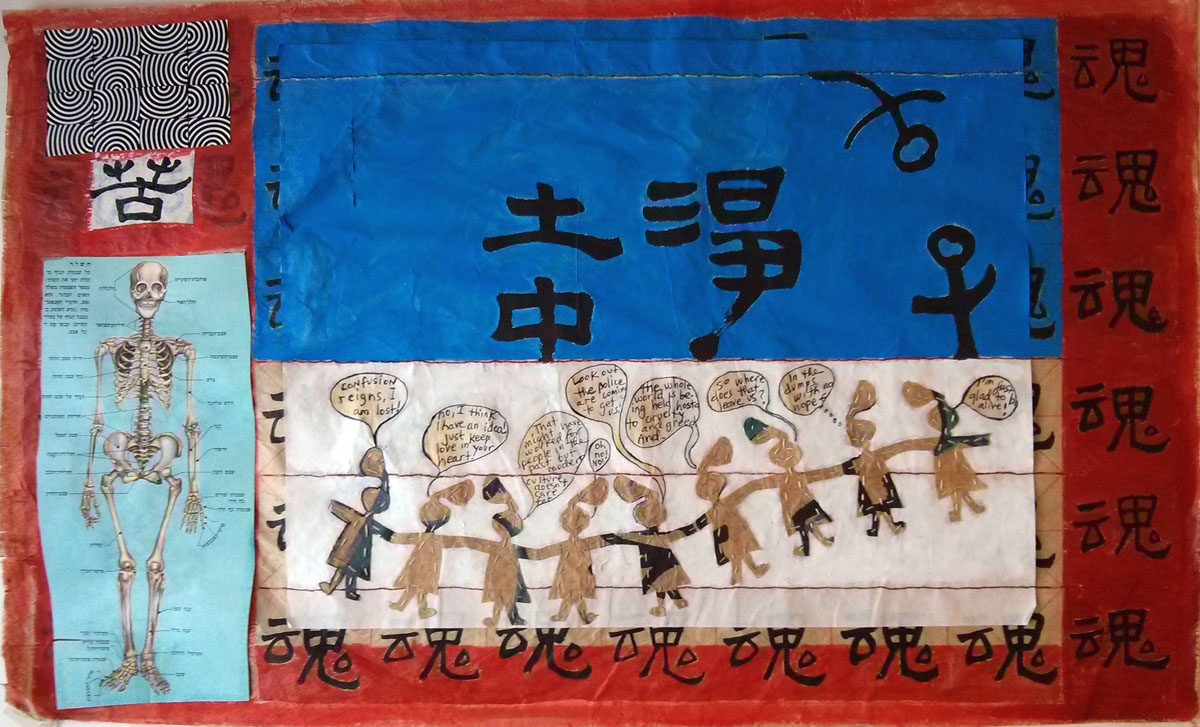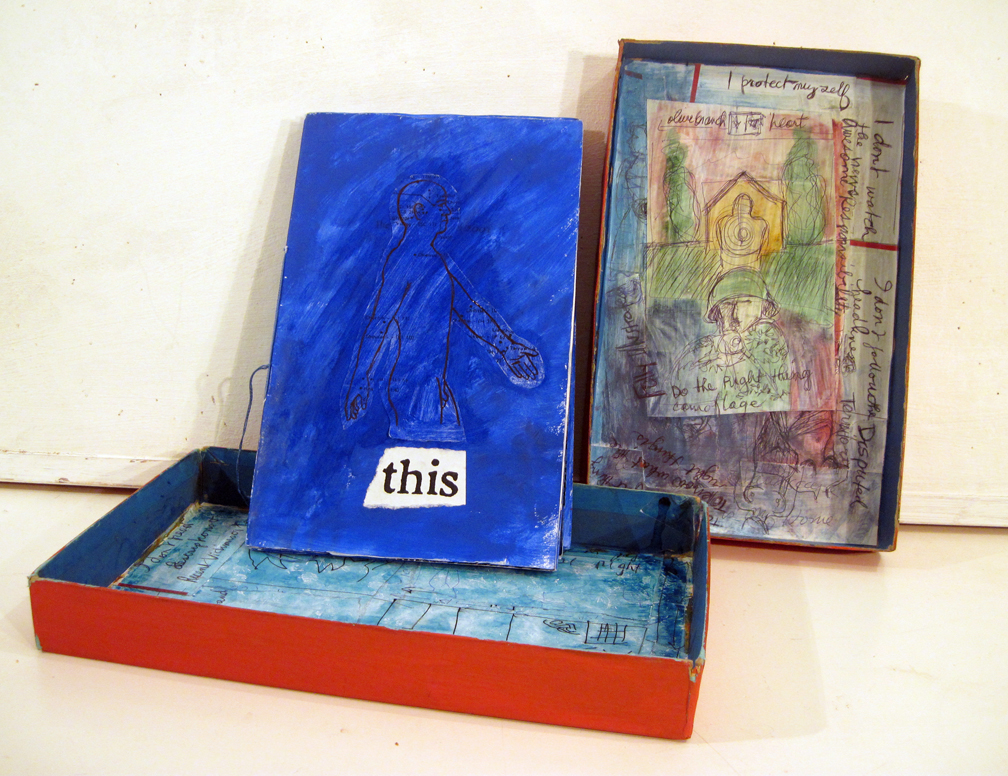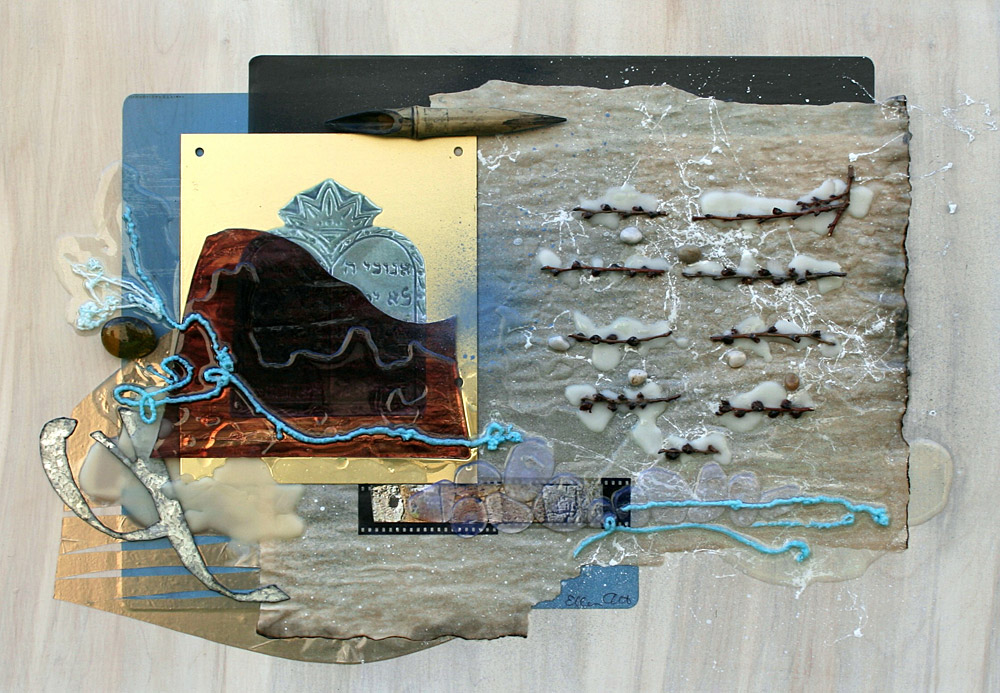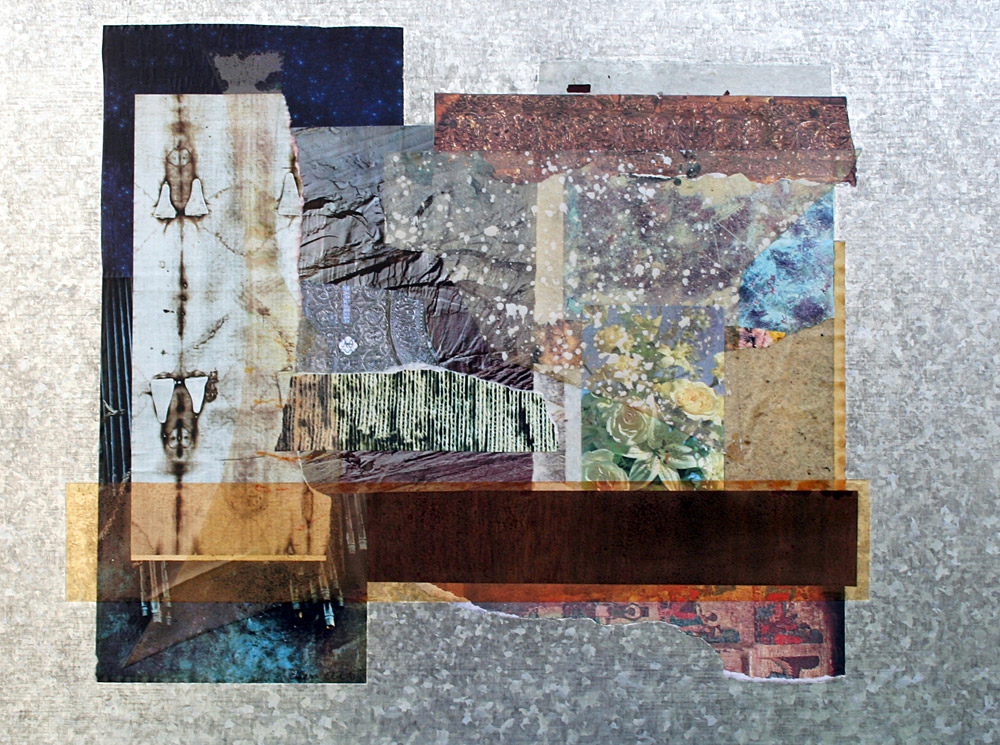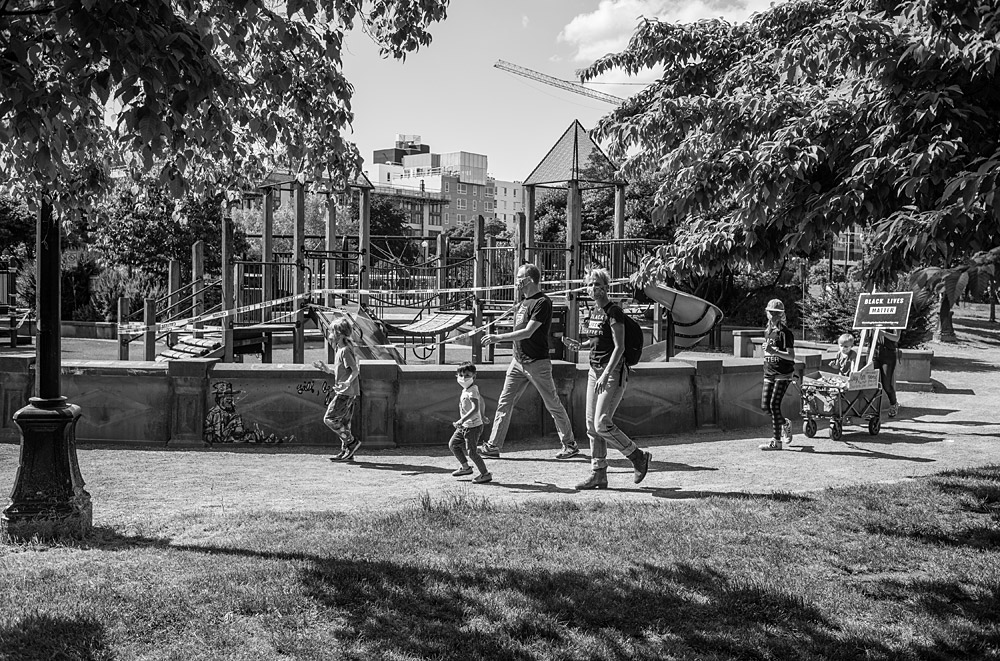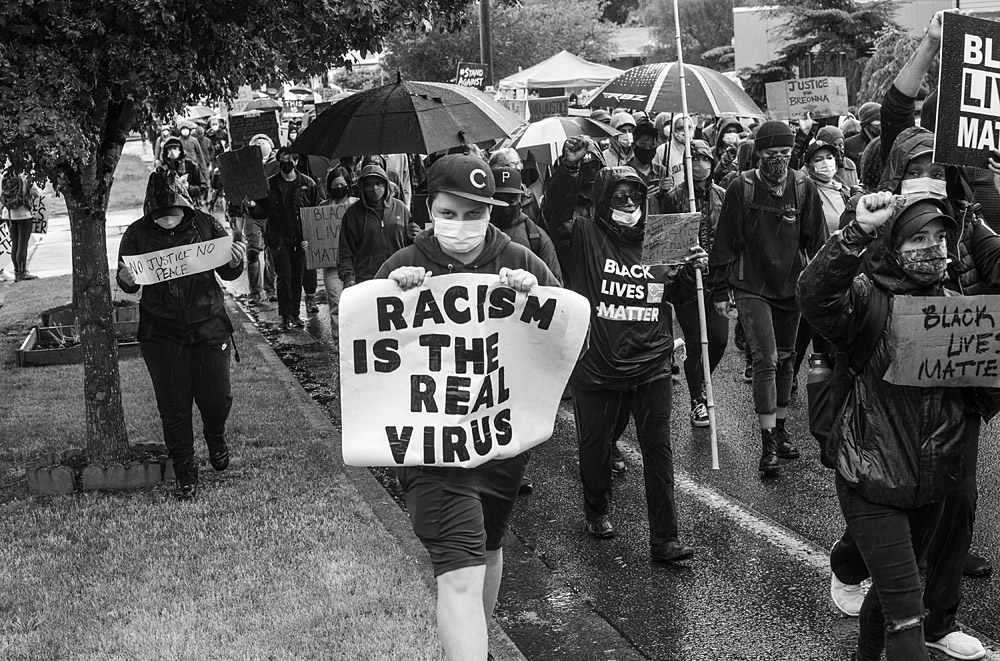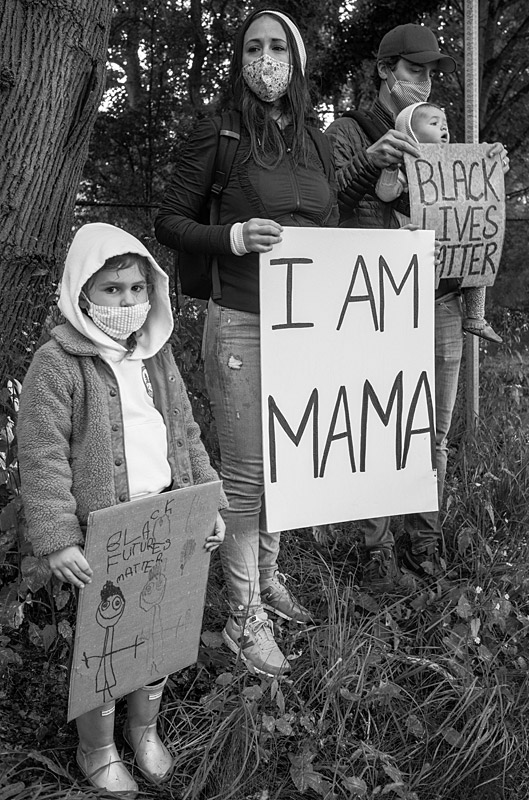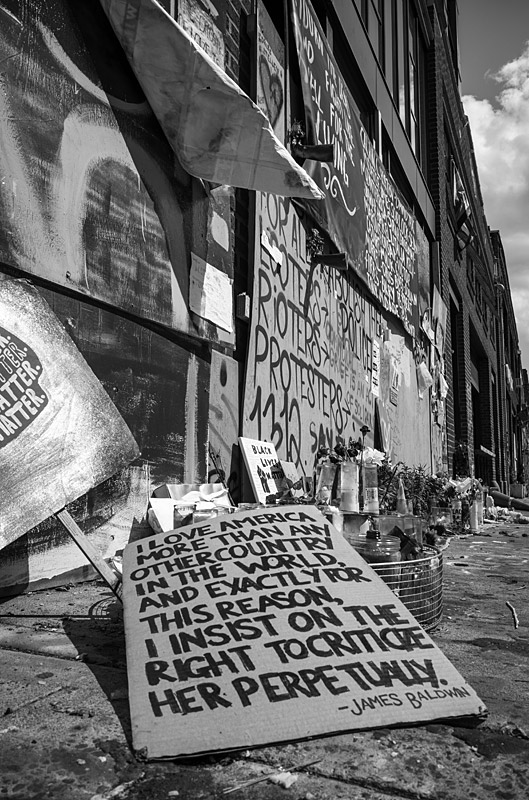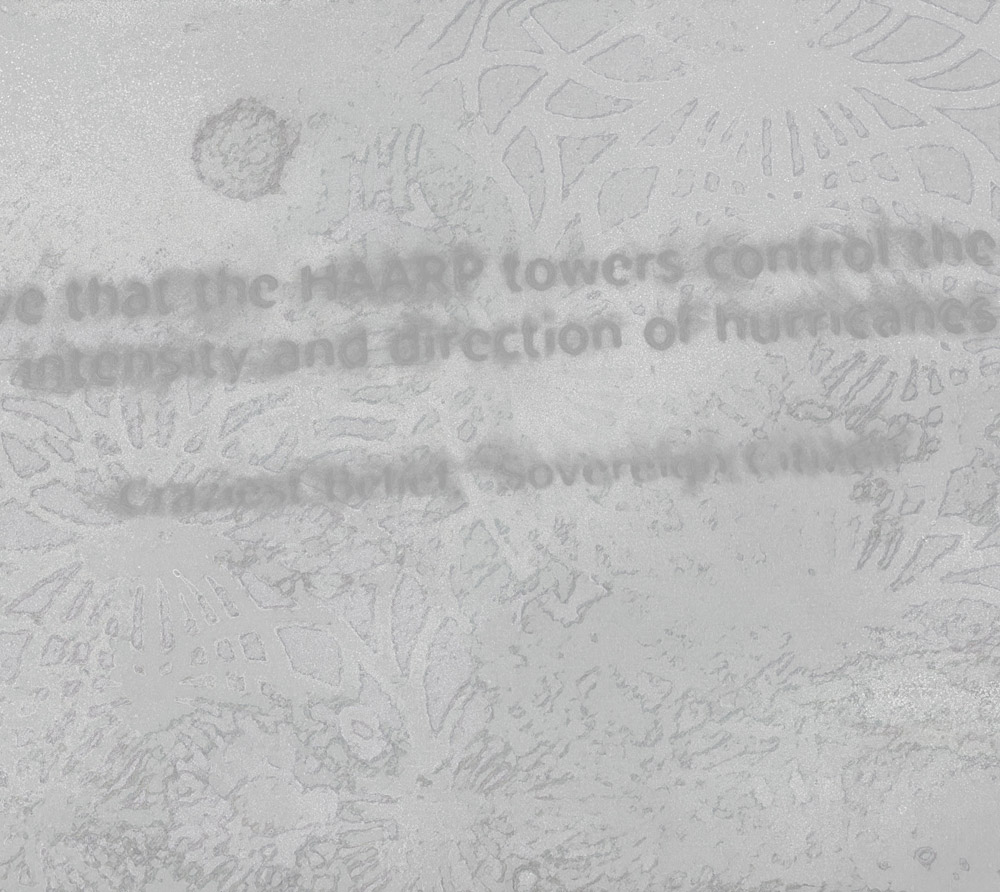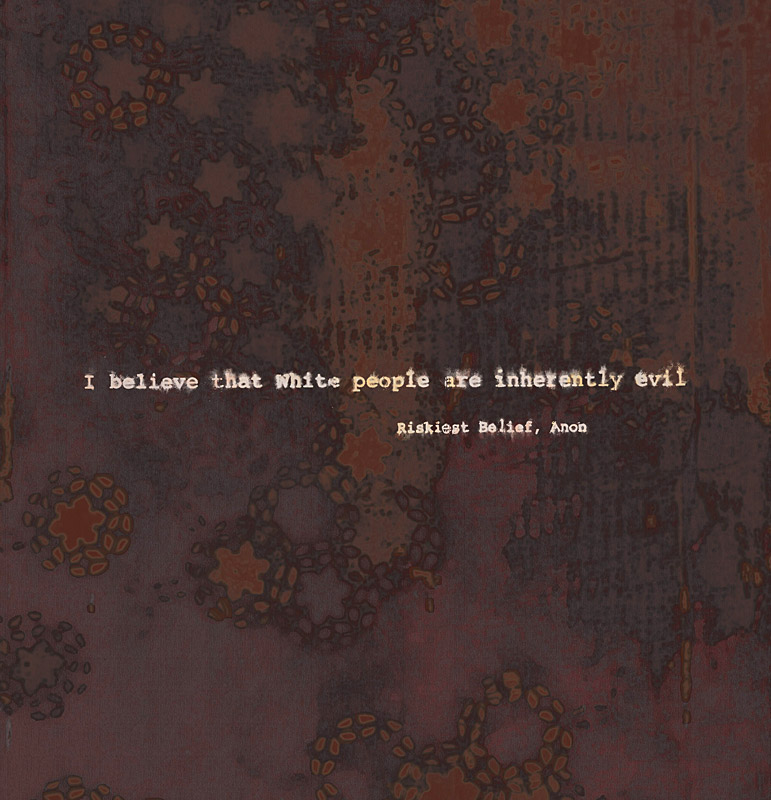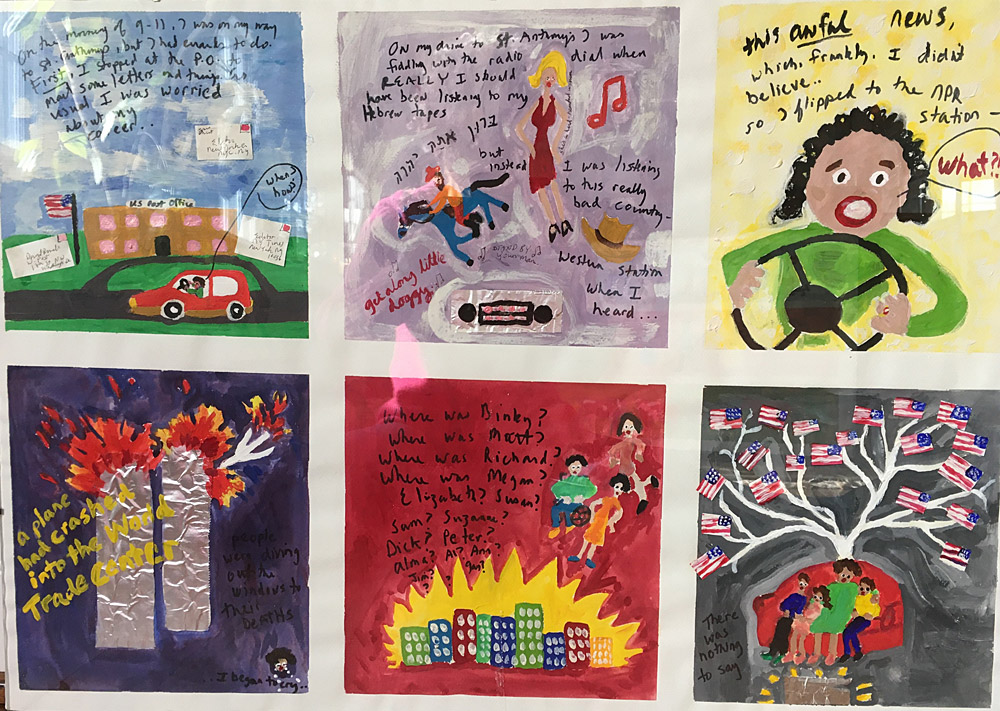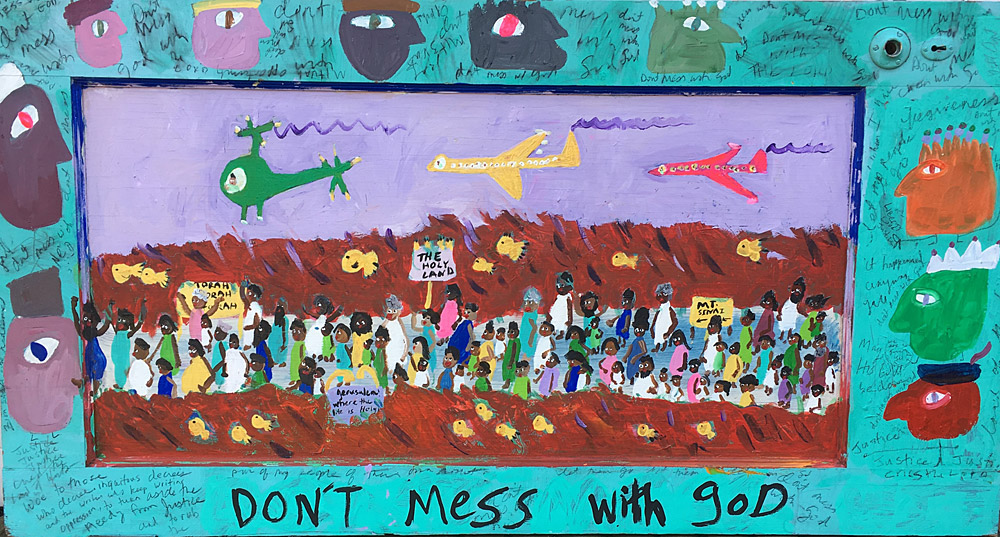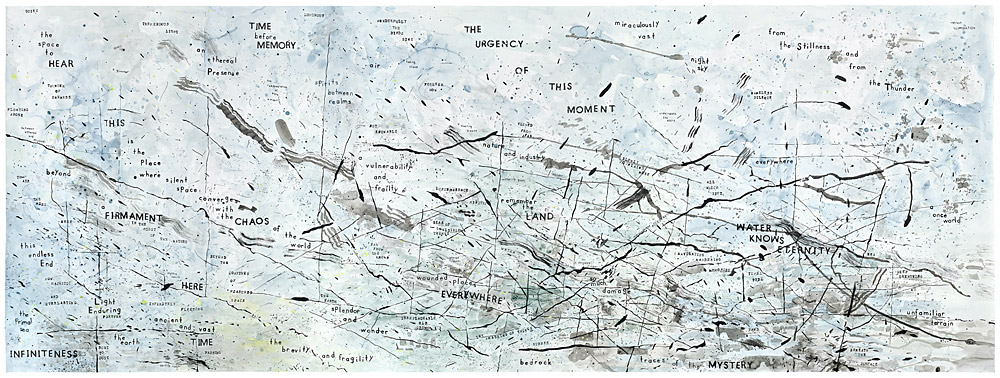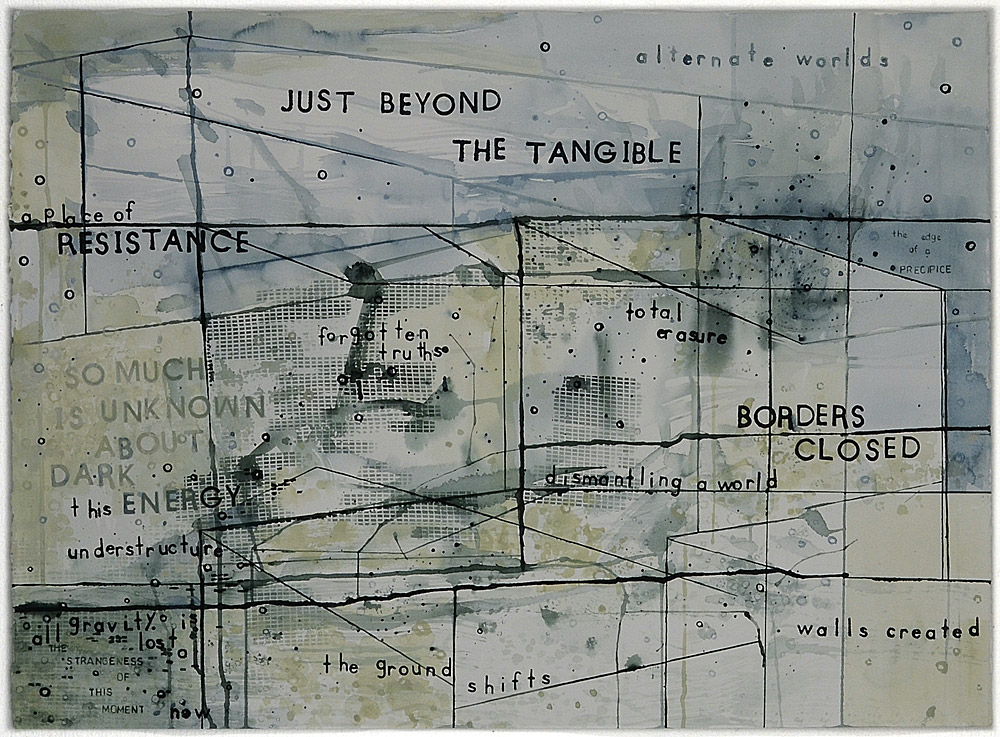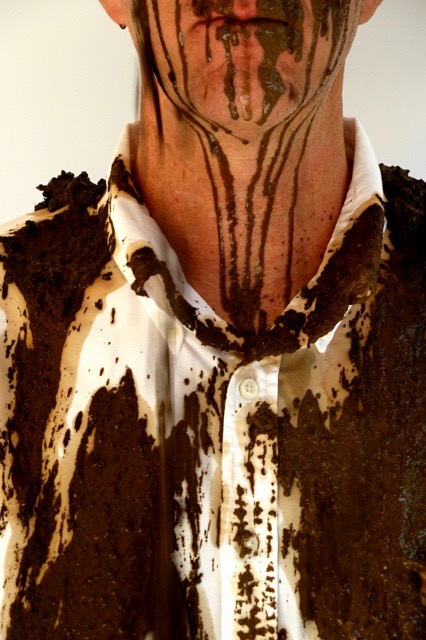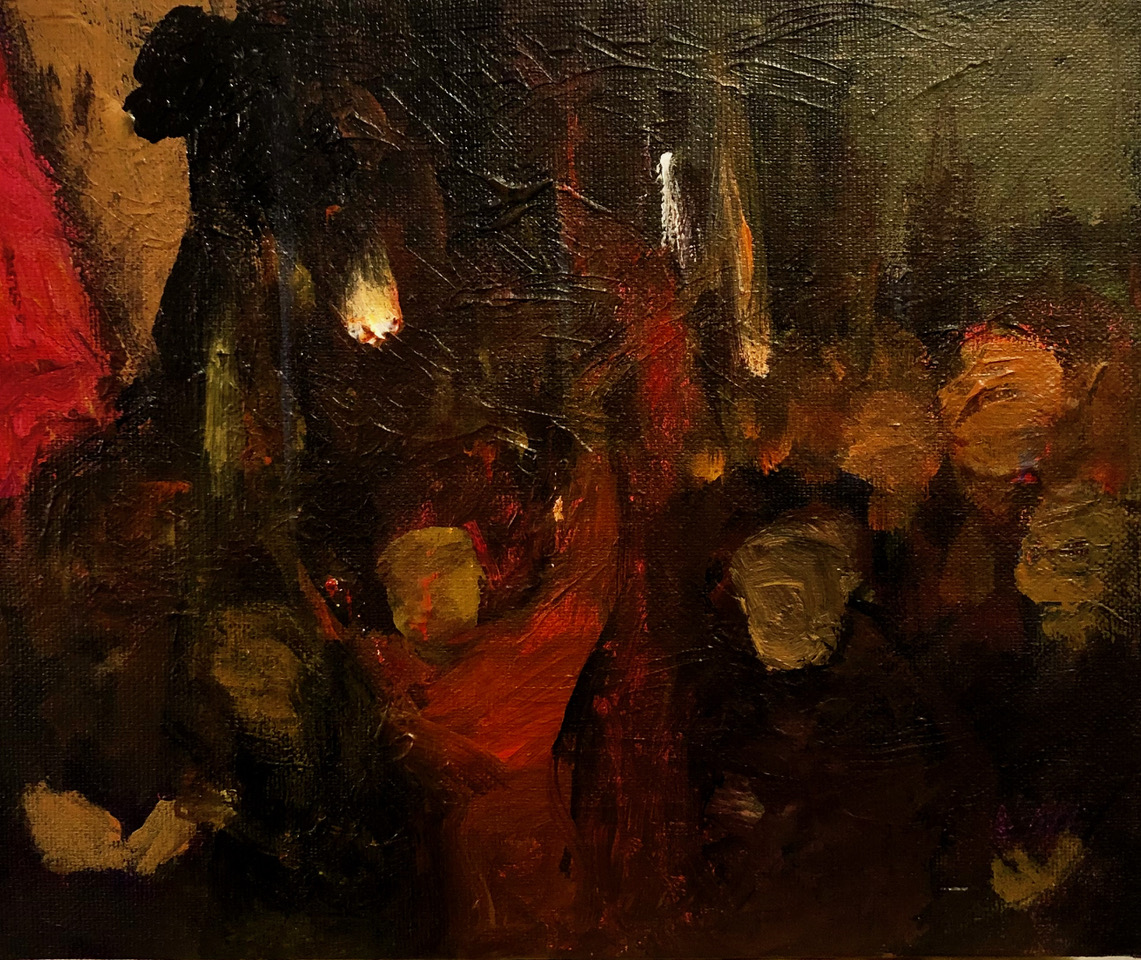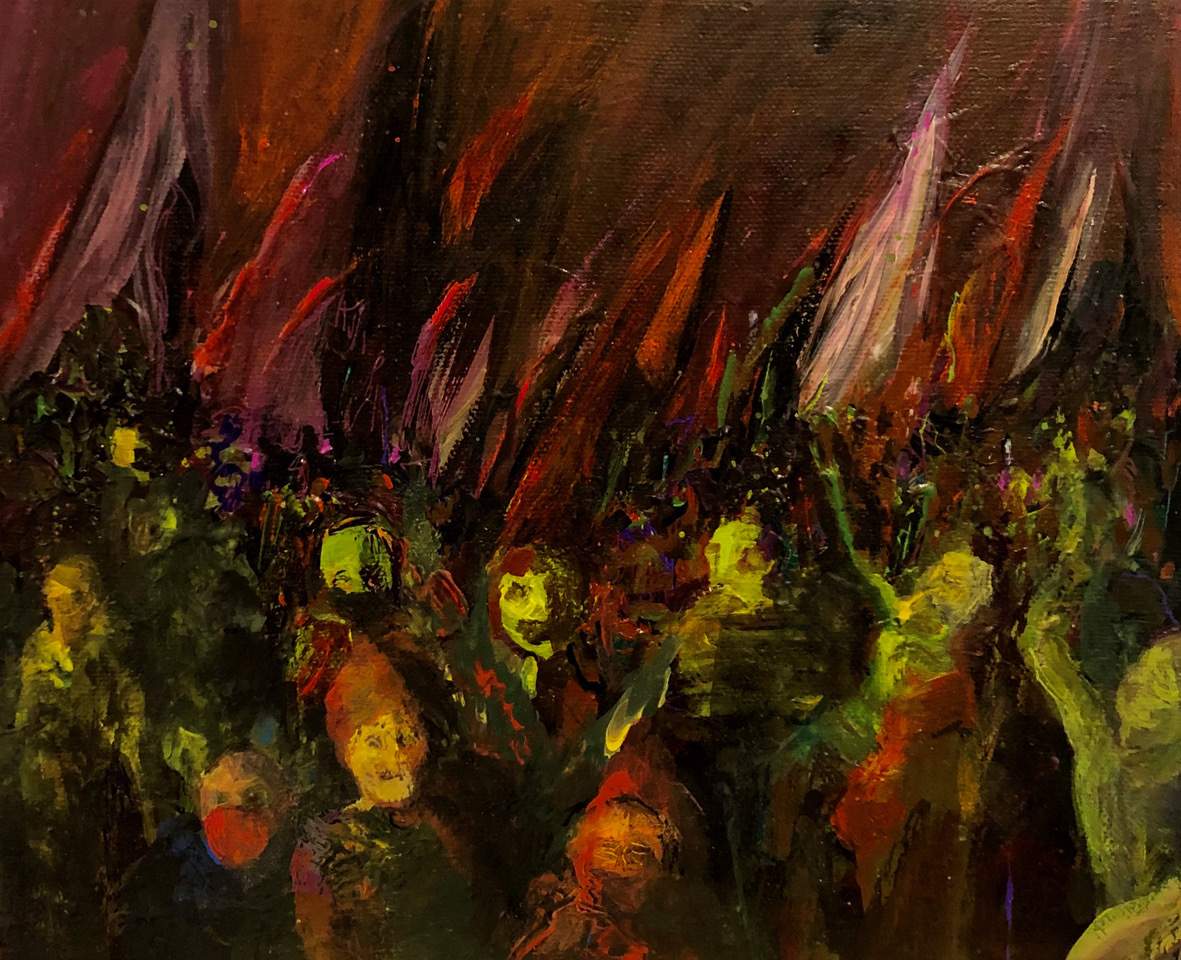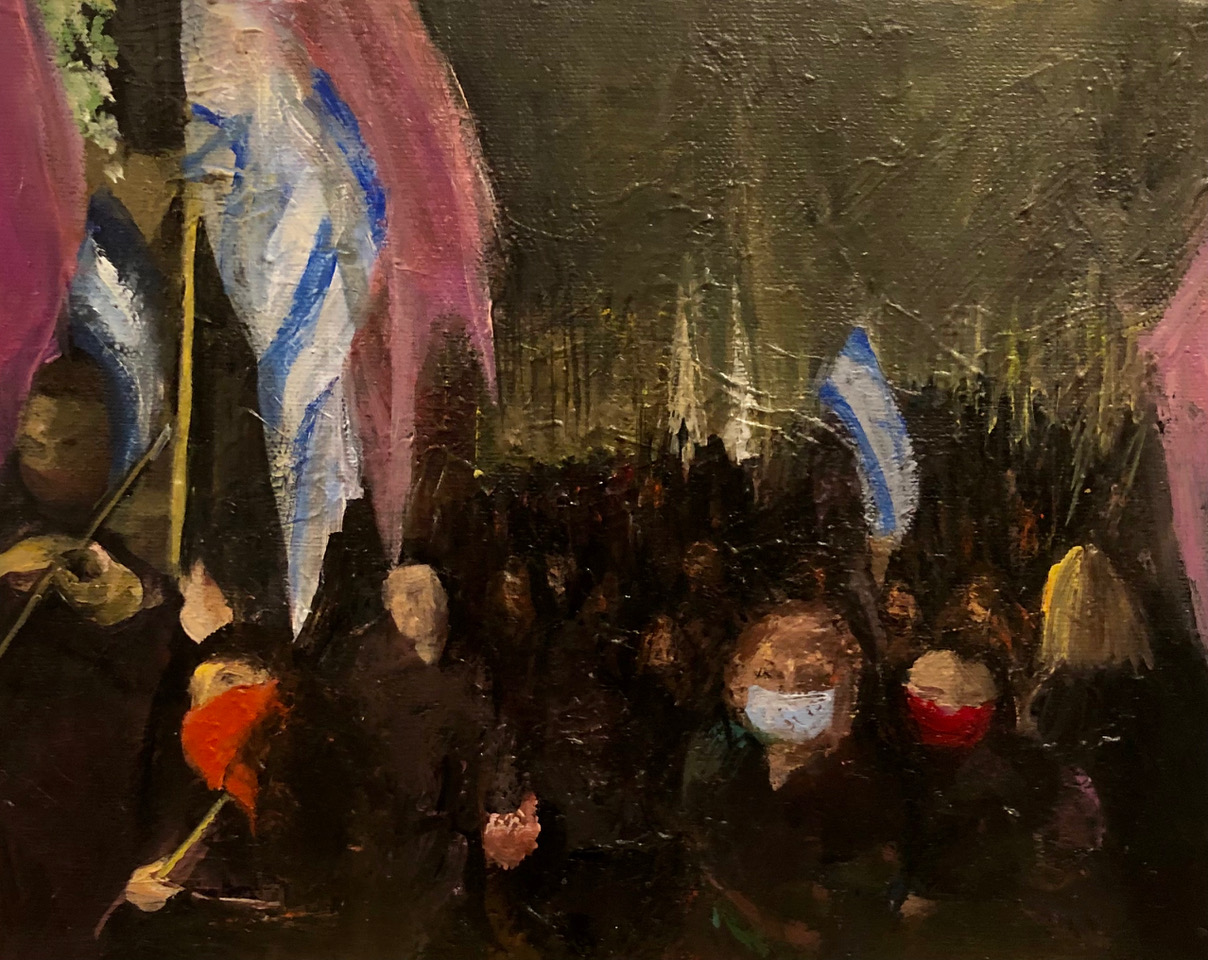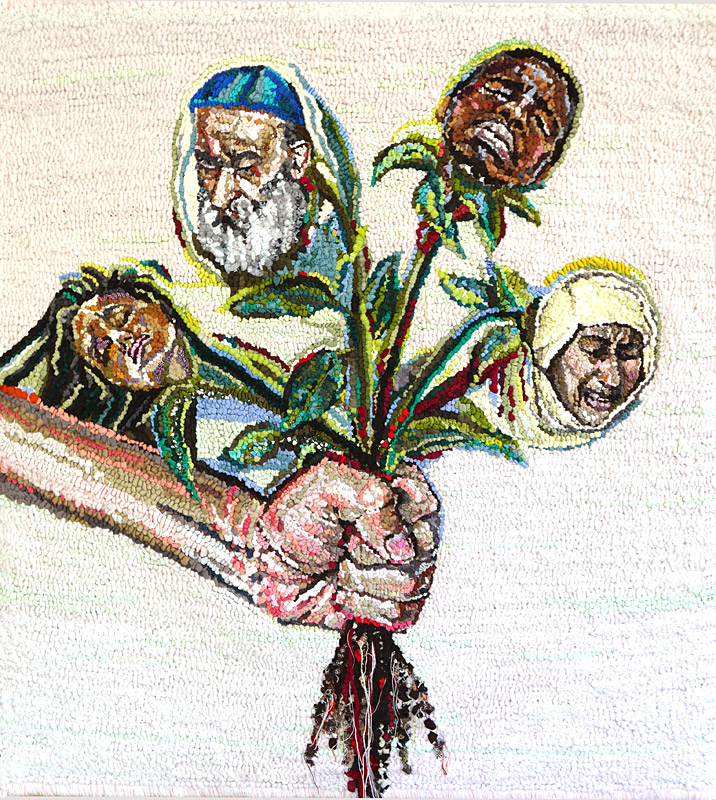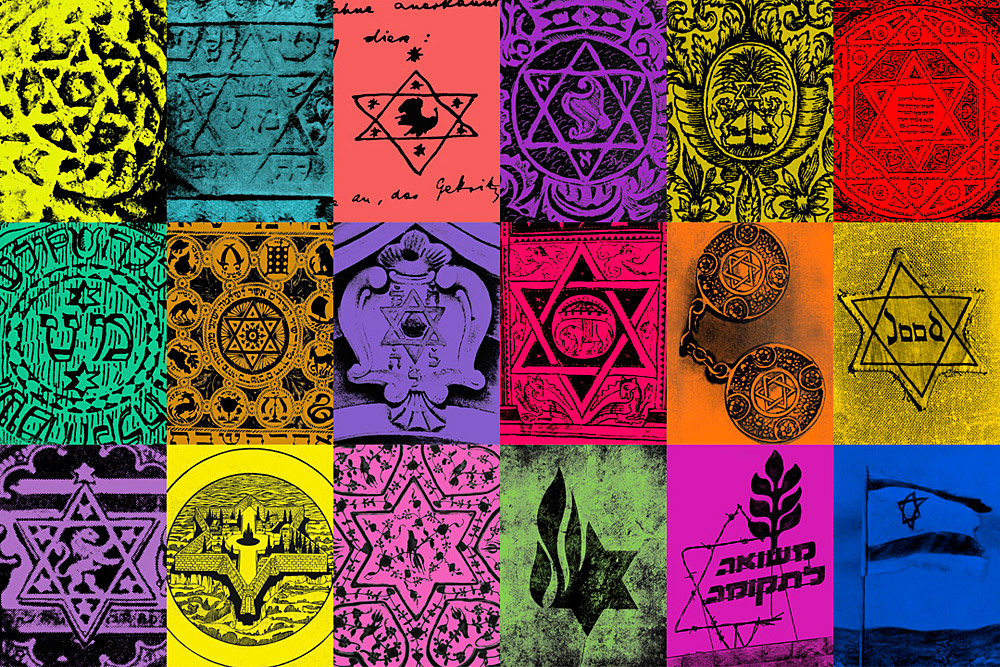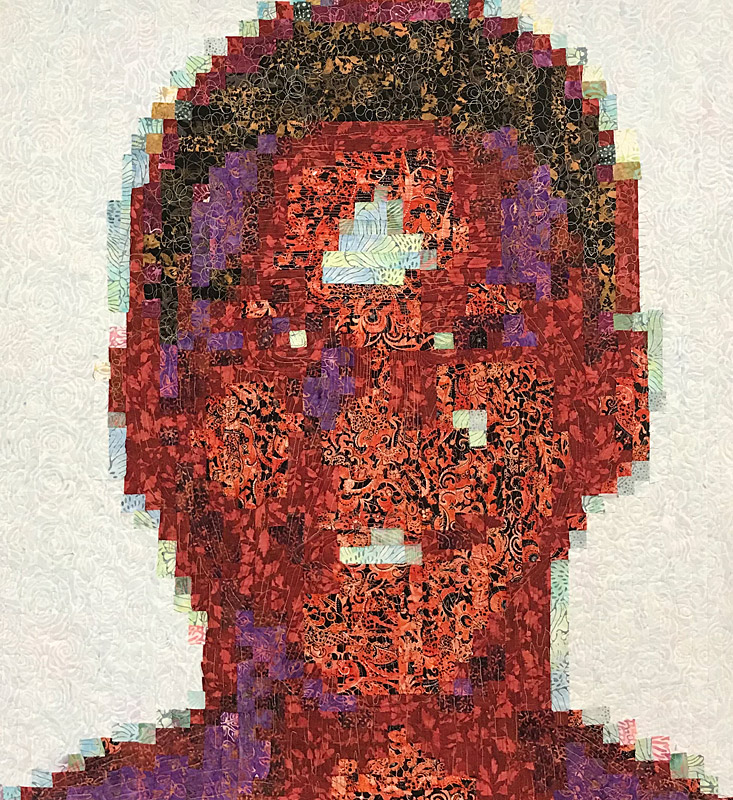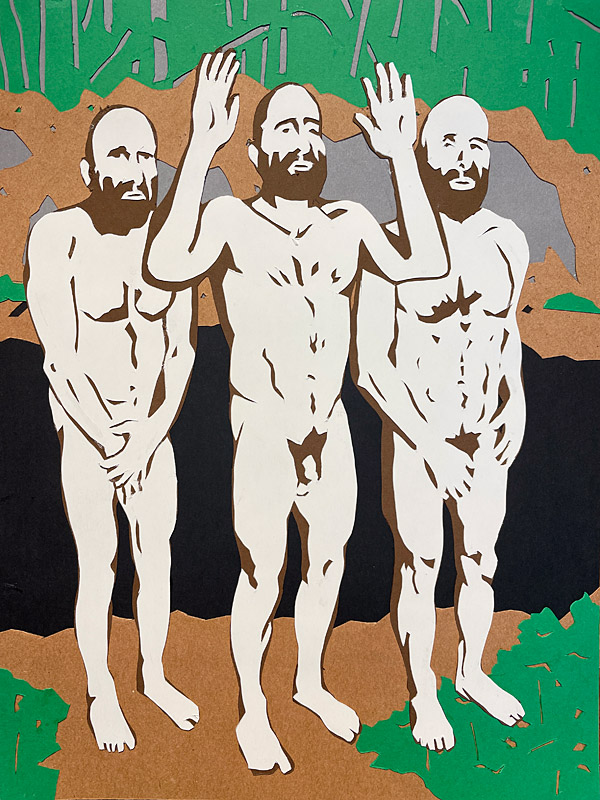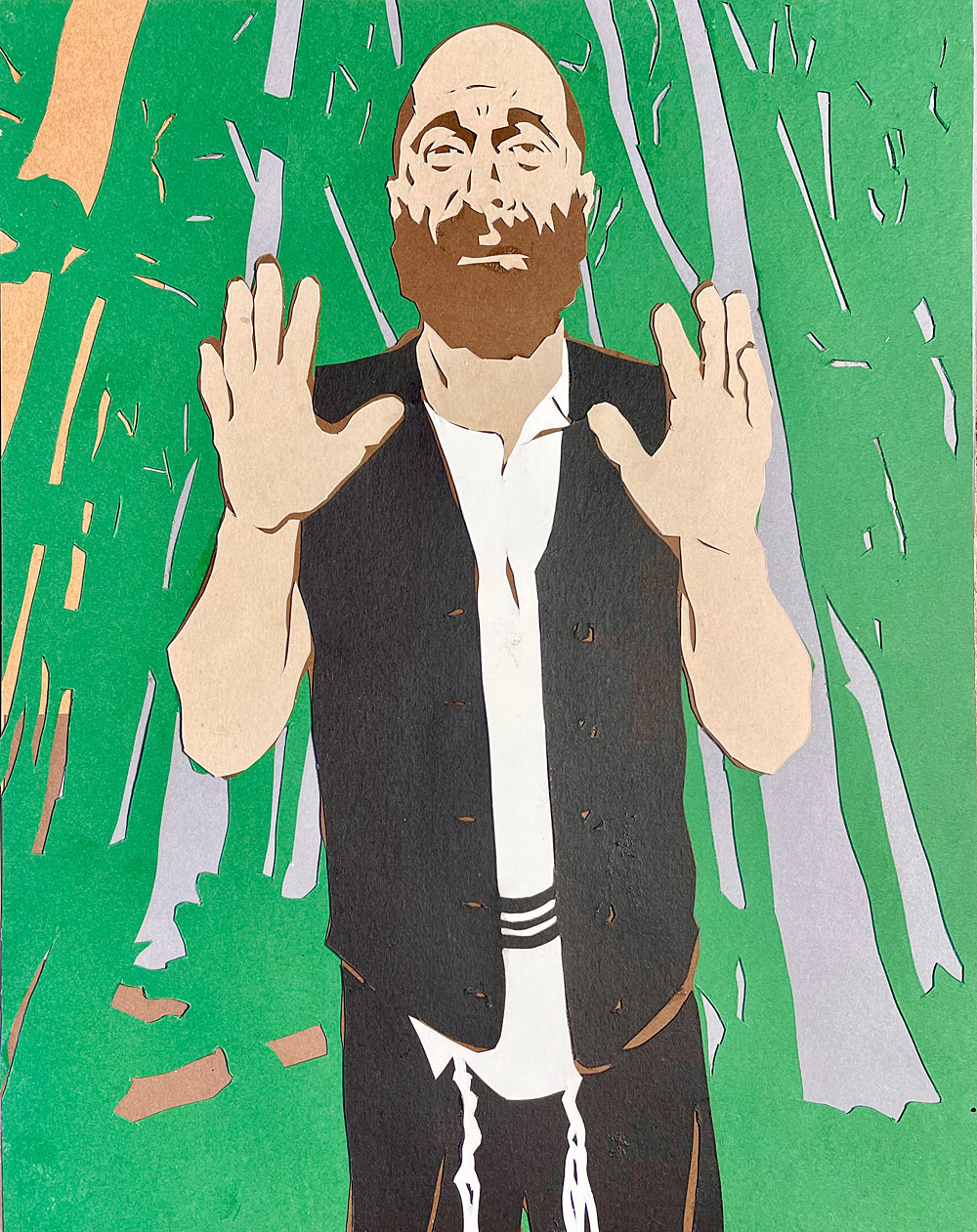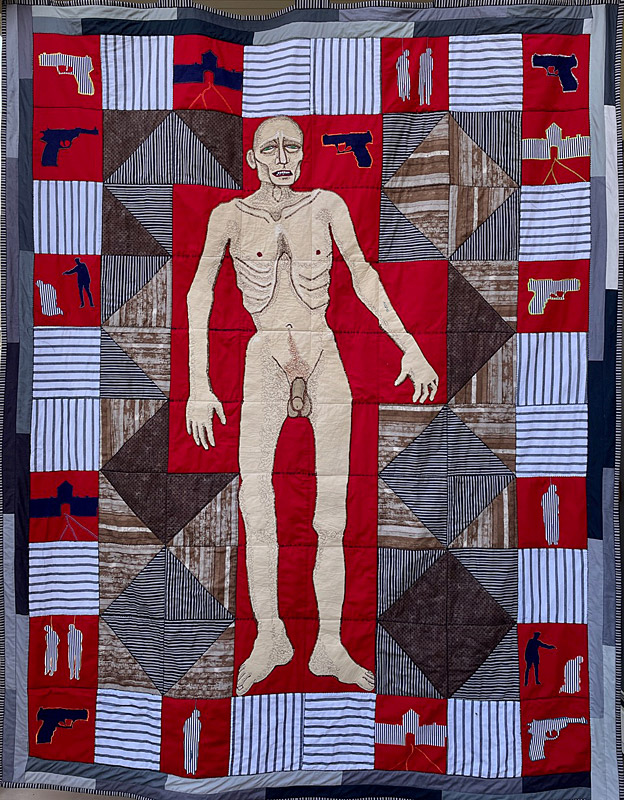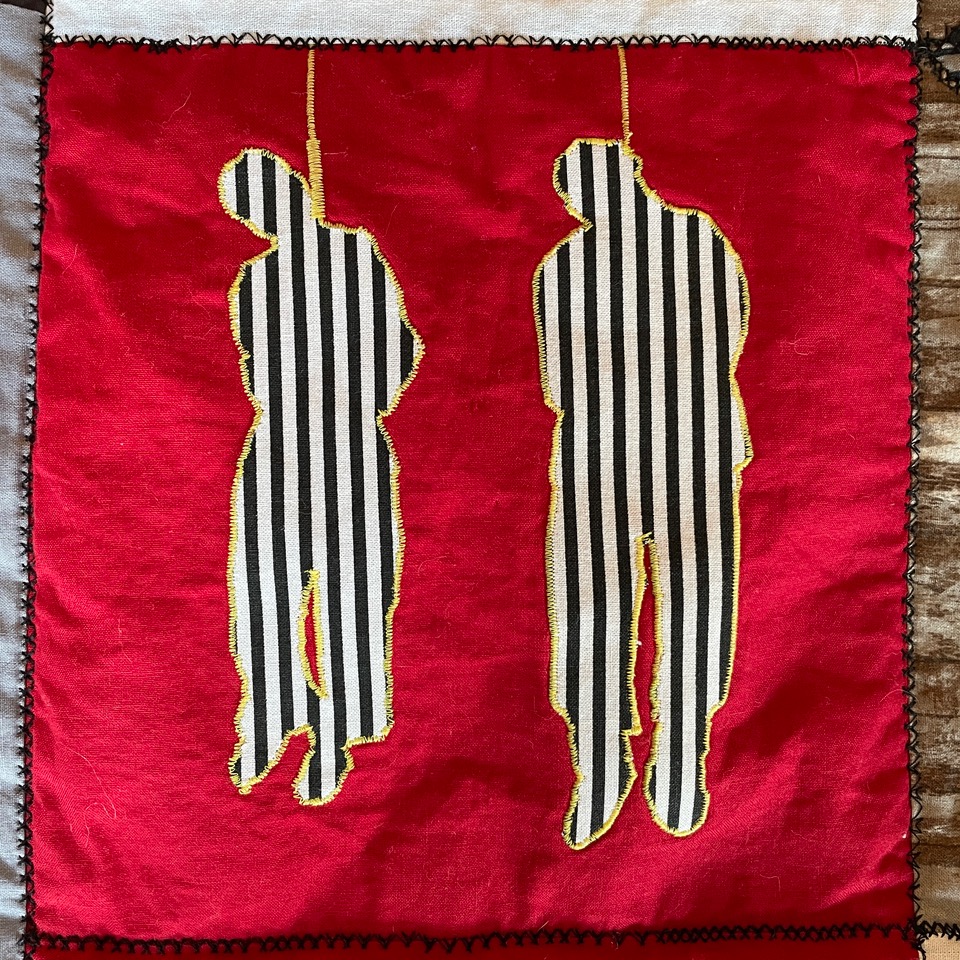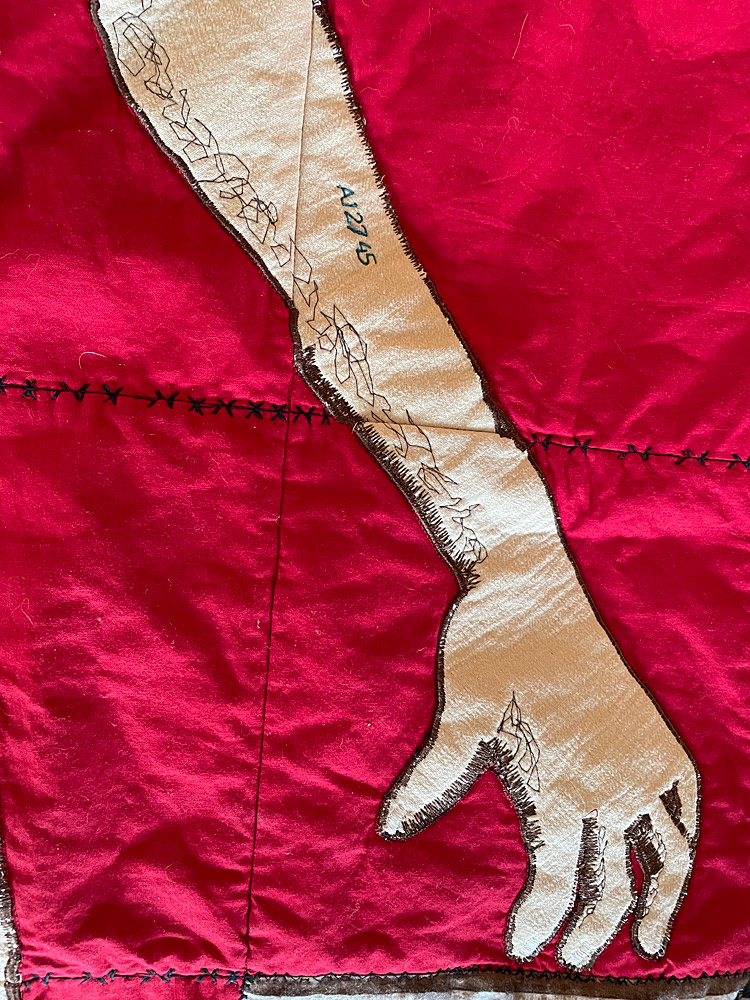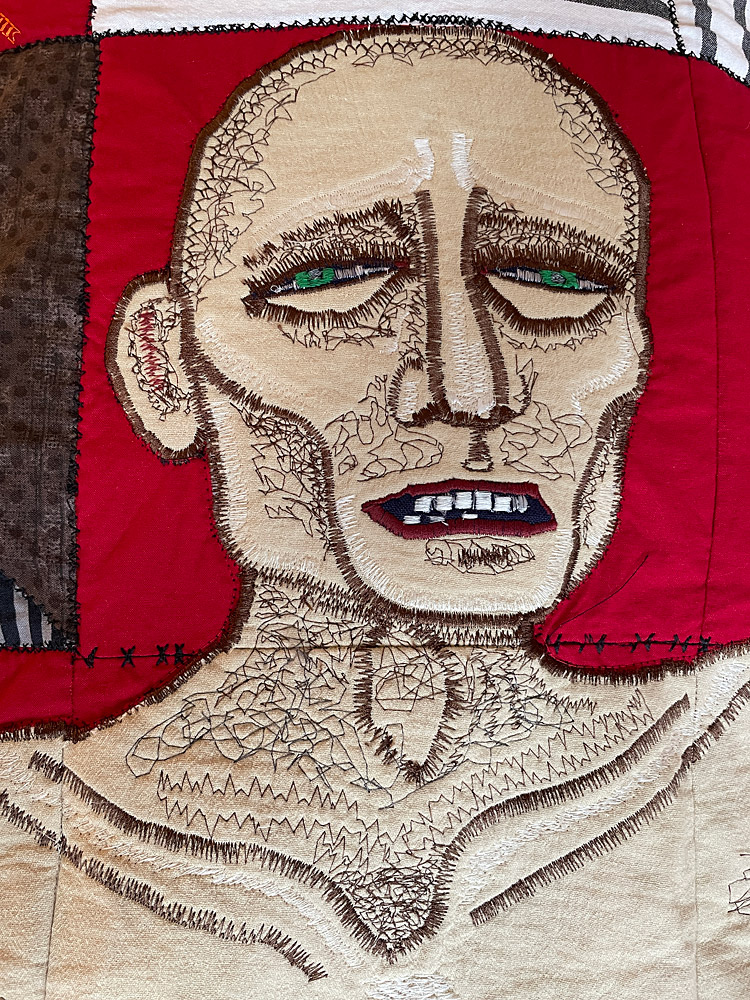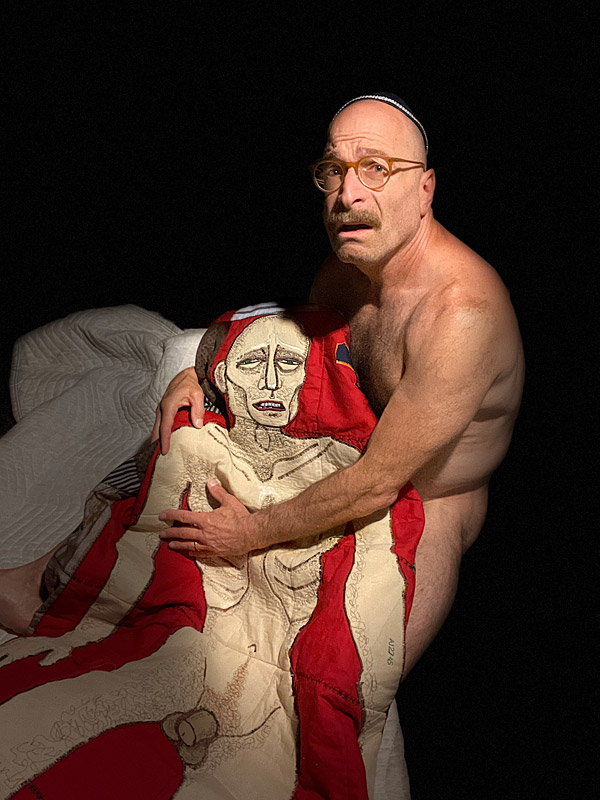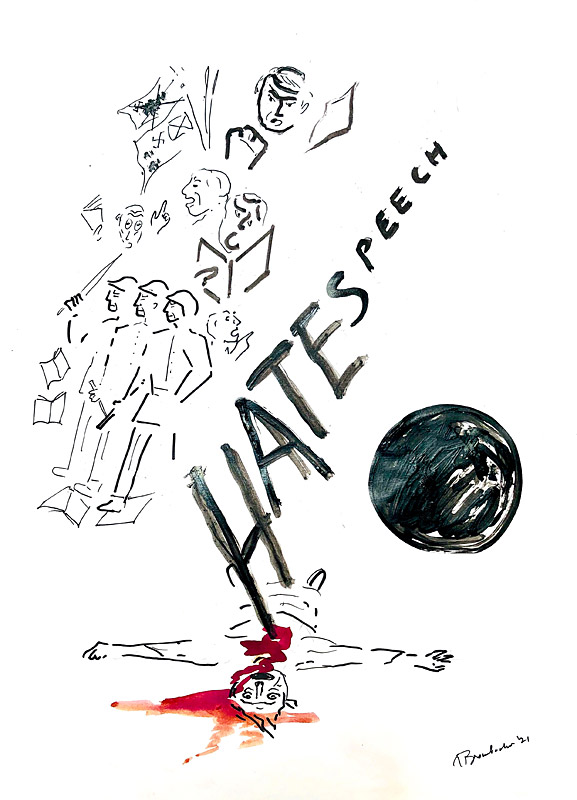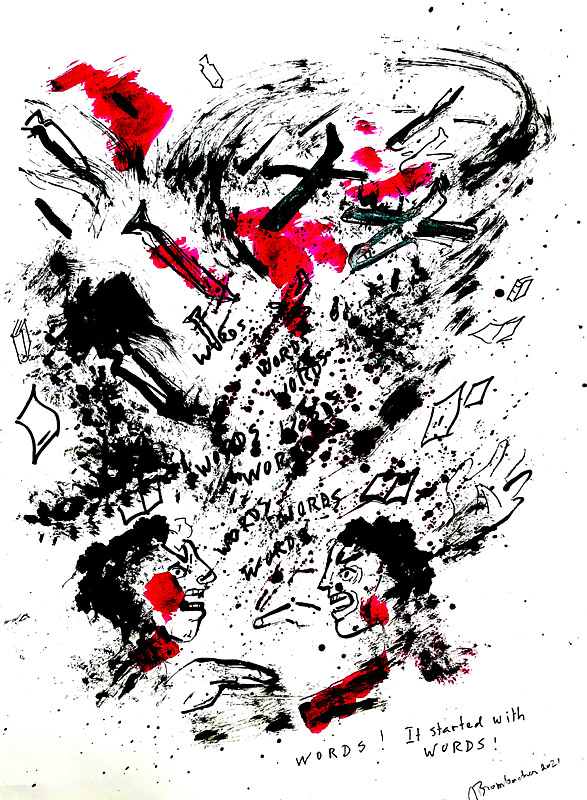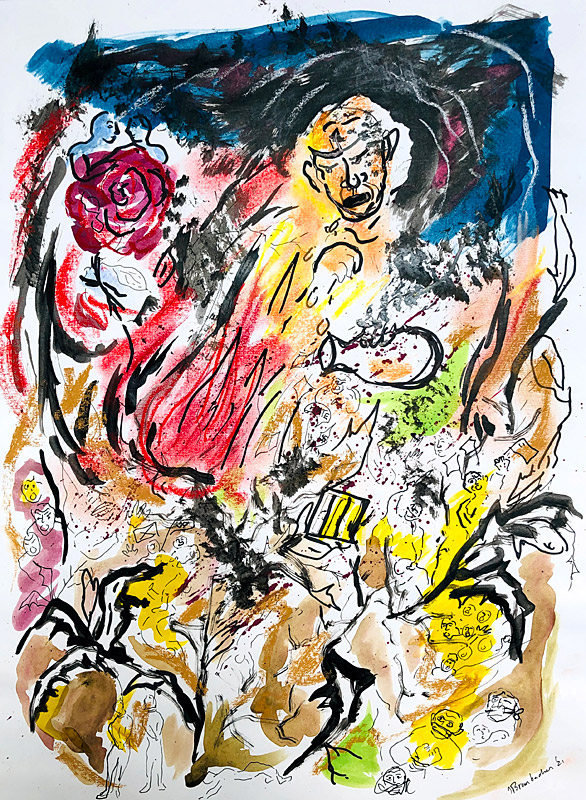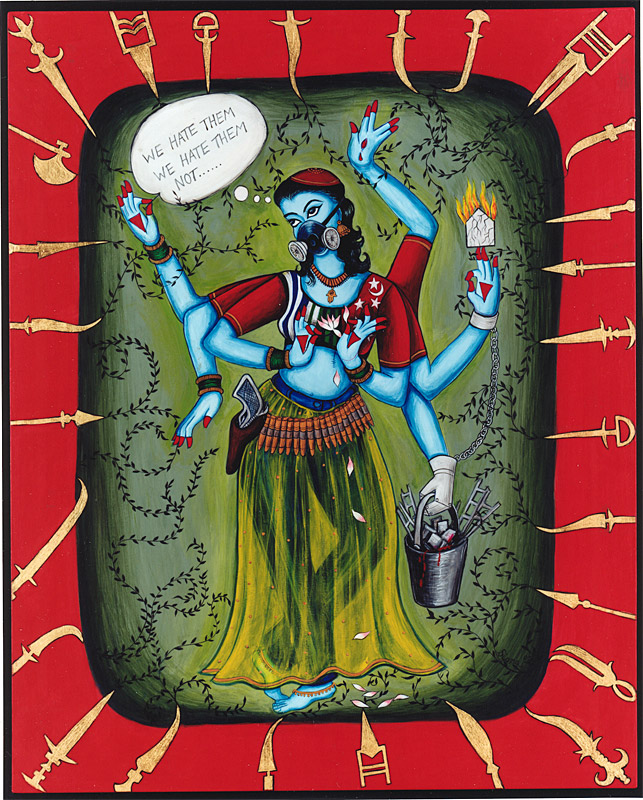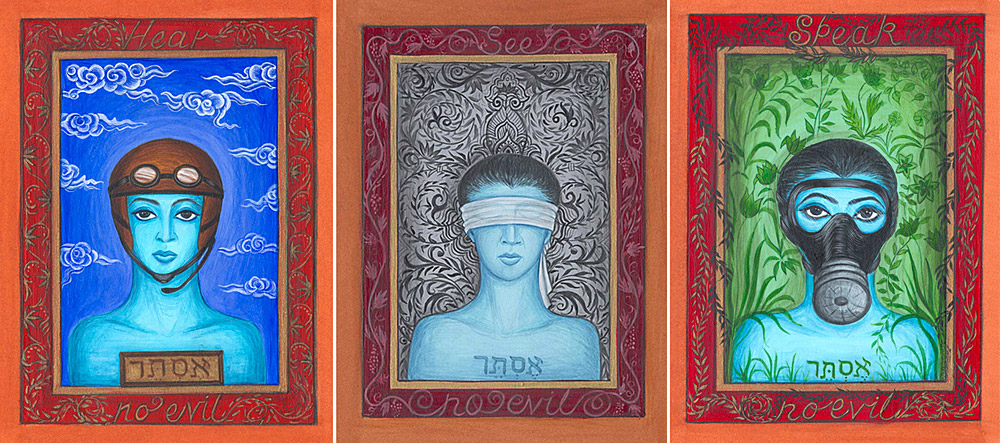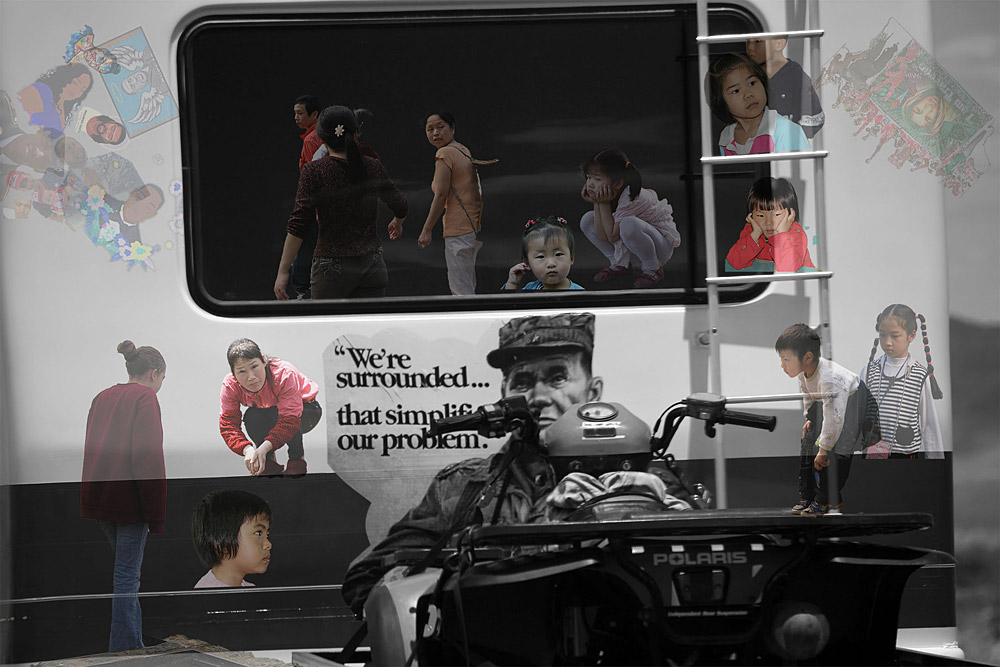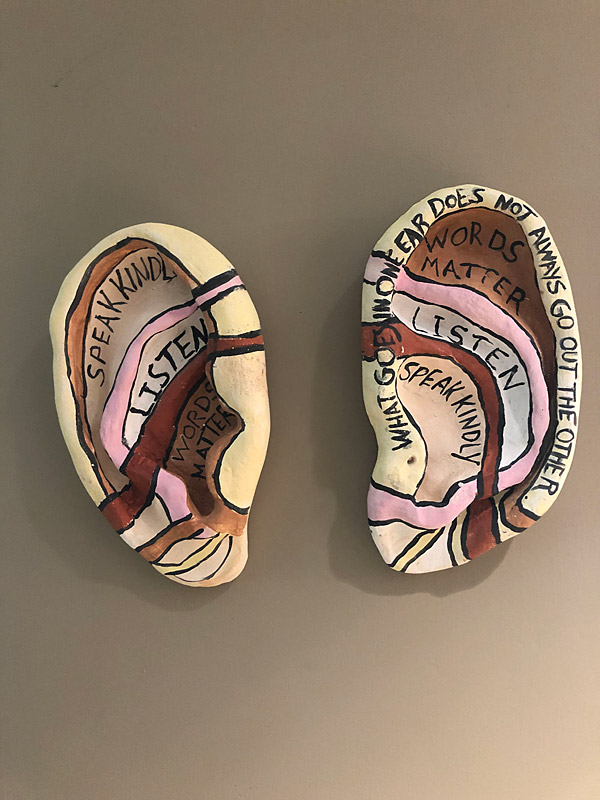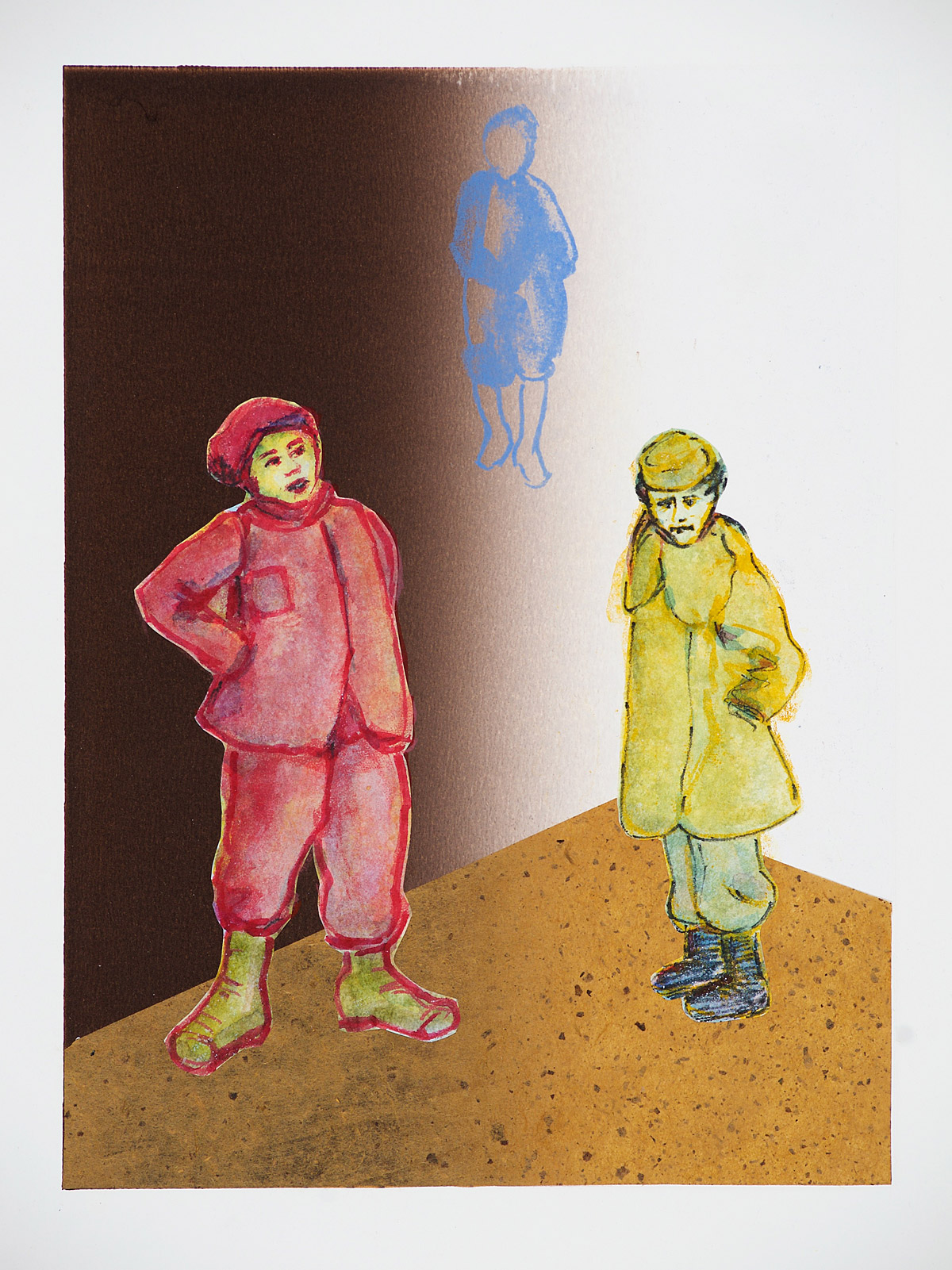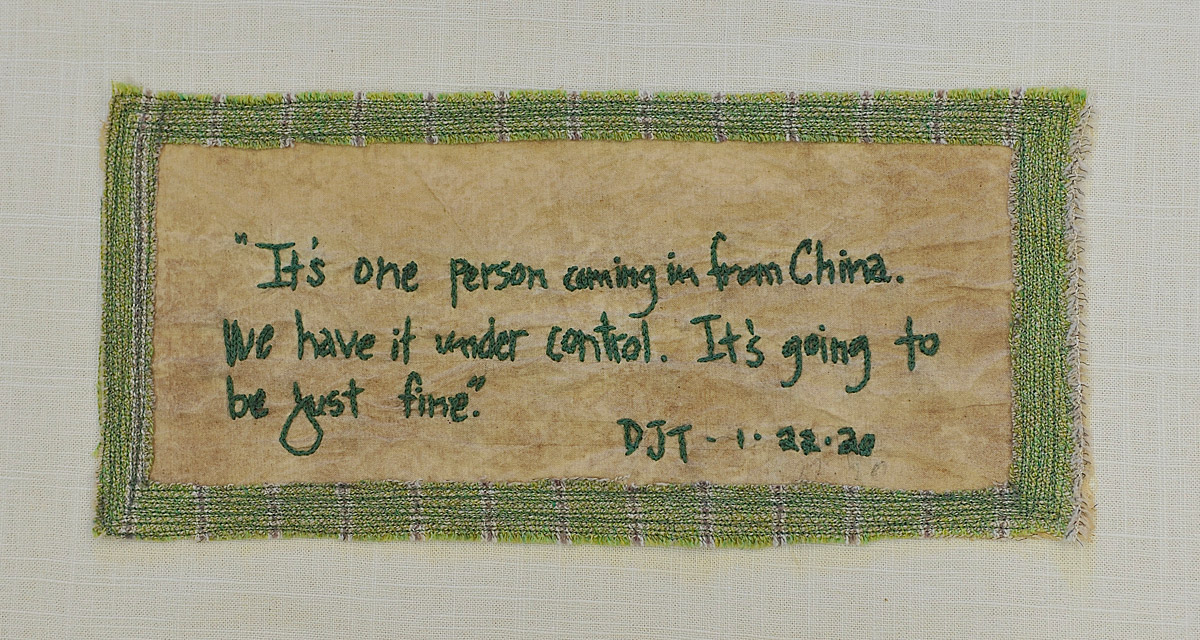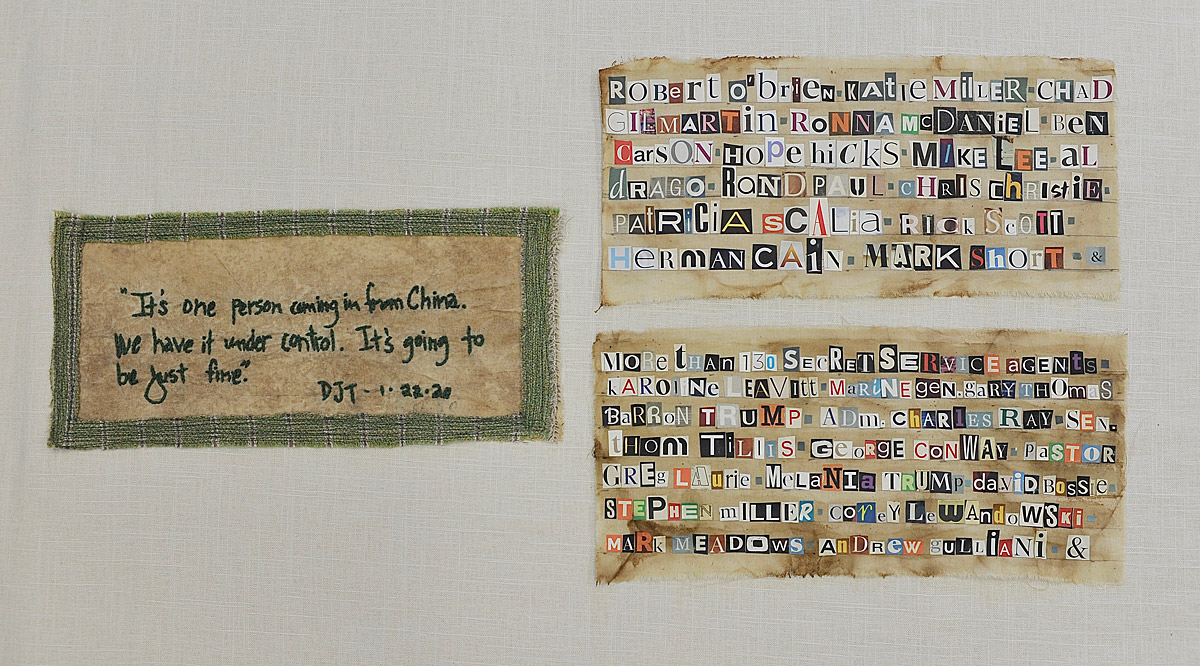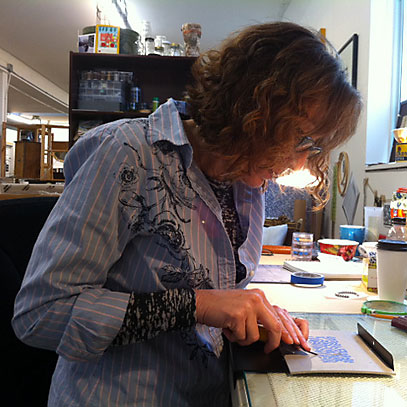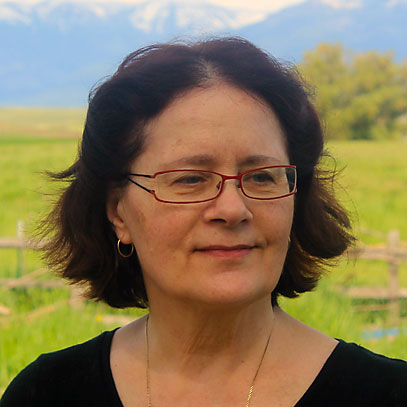On the Consequences of Hate Speech IV
Curatorial Statement
Words. Ugly words made of sticks. Words suspended in dark corners. Nasty words leaping out of friendly faces. Dangerous words cut to pieces. Warning words. Fateful words with chilling implications. No words at all, because we know what is implied, and the image is enough.
And there are the consequences: historical, ancestral, intellectual, cultural, painful, gut-wrenching, infuriating, violent, agonizing and more, all of them felt in a deeply personal way and demanding some kind of personal response.
The artists in this fourth iteration of On the Consequences of Hate Speech have lived through four years of a presidency we never thought we would ever see, where hate speech was encouraged and promoted against every person in our country on a daily basis by our own government. They are living in our now-polarized society, awash with inflammatory media and outright lies. They have also lived through a year and a half of a world-wide pandemic. All of us are tired of the continuing injustice, polarization, and the complexities of life, but these artists show us that we must not give up and let terrible things happen to our fellow citizens without reacting. We must choose our causes and stand up for them as we have the strength. These artworks are personal exhortations by artists, as each one asks the viewer to look, consider, and then marshal their resources to act for the sake of themselves and the next generation of humanity.
Yasher koach! May you have strength!
Robin Atlas and Nancy Current, Co-Curators
On the Consequences of Hate Speech IV
Andi Arnovitz
Names Do Hurt Me, 2018
Sticks, Stones and Thread on Canvas
36″ x 18″
There is a simple childhood rhyme: “Sticks and stones may break my bones, but names will never hurt me.” Today’s current geo-political environment is fraught with hate speech, with nasty epithets and using dismissive and ugly language has once again become commonplace.
This piece, created from literal sticks and stones employs every nasty, derogatory name for “Jew.” It is a visual, graphic reminder that hate speech and names can hurt and damage and wound.
ACID!
Acid violence is the deliberate use of corrosive acid to attack and harm another human being. The victims are predominately, but not always women and children. The horrific fact is that the attacker usually throws acid on the victim’s head and face to disfigure and blind them. These acts of violence rarely kill but maim and create psychological scars for life.
This violence occurs world wide and is not limited to a single race or religion. Some of these attacks are more notorious, such as the attack on Sergei FIlin, the director of the Bolshoi Ballet, or the attack on Maria Fernanda Nuñez , a beauty pageant contestant in Columbia South America. Regardless, in all cases, public and private, the victim’s life and appearance is destroyed forever.
Ironically, artist’s use nitric acid in the etching process- one that usually results in a beautiful work of art. Here I have followed the traditional time consuming methods of creating portraits with etching, but then, I destroyed my plates by spilling acid and letting it eat into the portraits.
These works are meant to create awareness and educate people to this growing trend. Each of these portraits is of a real person whose life was destroyed. “ACID” is a study in shattered lives and the permanent scars such acts of violence leave.
Andi Arnovitz
Jerusalem, Israel 2015
Avy Ashery
Historical Timeline Illustration of Anti-Jewish Events from 70CE- 1948
Watercolor, Marker, Pen and Ink on Paper
26.5″ x 15.5″
This timeline illustration reveals the destruction brought on by hate speech over the last 2000 years up to and including the creation of the State of Israel.
Beth Haber
Flotation Devices for the Great Wave
Acrylic, Pencil, Mylar, and Mixed Media on Archival Board
18″ x 20″
The 19th century master woodblock artist Hokusai’s print “The Great Wave off Kanagawa” is vastly familiar and widely reproduced – appearing in jigsaw puzzles, clothing, and endless copies. I first came upon a print in school studying Japanese art and was mesmerized by the brilliant depiction of cresting water paused and anticipatory. His print captures the precise precipice of consequence when an overwhelming force is unleashed.
Only recently while examining a large version of the print at a doctor’s office, did I fully notice the tiny humans in simple boats entering the cresting wave. Who are these voyagers about to be engulfed by the wave? We are these voyagers.
We are navigating waves of desperate people, violent weather, violent speech, and viral grief.
The flotation devices are rolled and tied as wanderers’ bundles – attached as offerings to survive the wave.
Lila Fayler
I make shard art. The tragic experience of losing three of my children and my brother in the crash of his light plane means that I can never be a whole person again, but I can make art which reflects my desire to honor my children’s memory, the process of being broken, and the healing which can be achieved.
The tragedy of losing my children seemed to stimulate a primal fear of loss in the people around me, resulting in frequent personal attacks of angry hate speech. At first I was put on a pedestal, and then vilified, as people’s hidden agendas were revealed when they found they couldn’t control me. They would “help” me, according to their needs and not mine, and then demand that I show appreciation by following their dictates. I was a catalyst for the classic tribal desire to excise the pain of loss from the midst of the community by victimizing the victim. In my artwork I create a narrative in order to empathize with others who also experience the pain of hate speech.
Dual Man, 2018-2021
Clay and Porcelain
10″ x 8″ x 3.5″
A man of dualities, both light and dark, is also composed of shards. His personality and identity are perceived as not well-integrated, provoking others to assault him with words of derision. He represents the struggle many have to fit into a society which does not appreciate differences in people.
Nature’s Entropy, 2018-2021
Clay and Stones
11″ x 7″ x 5″
This man, an outcast, has been broken by those who reviled him with hateful words. However, he has found meaning in his broken state, and has reconstituted himself with the help of nature and the goodwill of others. He is a survivor, having found beauty and strength in his new self. The stone is broken and worn smooth by time which allows the acceptance of brokenness, including the healing of the broken shard face.
Contact: office@vectorartistinitiative.com
Billha Zussman
Investigating the Nature of Hate Speech
I have been working this last year on a new series of photographs inspired by Hanna Arendt’s life and philosophy and the urgent relevance of her ideas to our existence in the present time, including crises of education, totalitarianism, antisemitism, racial unrest and populist movements.
We all use words to create and destroy new and old worlds. The only way to find our way out at a time of crisis is to believe and recognize the power of words, the way we use them, and believe in the power of talking.
It is the personal struggle of each of us against social and historical fixation, patterns and legacies that is what Arendt calls “the burden of mankind”. This mankind of humanism also cultivated and justified for generations a history of evil in all its forms – imperialism, colonialism and racism – always aimed at excluding and trampling the OTHER.
What strikes me in Arendt’s observation of human kind is that “….no person is entirely free from being conditioned by images, words, prejudices, concepts of beauty and ugliness, clichés or social norms that they grew up with and which abut exclusionism and racism.”
The keywords are: THINKING, TALKING, DARING TO ASK PROVOCATIVE QUESTIONS!
My new series of photos, The Weight of Words, is inspired by Arendt’s book Eichman in Jerusalem – the Origin of Evil.
In the photos we see Arendt’s book as well as its subject, being hung or weighted on a hook. Her book The Origin of Evil has been controversial for decades. She was banned from public consciousness especially in Israel, because she dared to ask provocative questions. In fact, she underwent sort of a cherem (a form of exclusion from the Jewish community).
The location of the images is a dark and hidden place. It is as if one is trying to hide from all the uncomfortable, confronting questions raised by this book. Simultaneously, we watch a pile of books (ready to undergo the same treatment?). I want these images to make viewers pause and dare to ask themselves thought-provoking questions, weigh the meaning of the book and the words, not in secret but in public, in full light.
Weigh your own motives, do not condemn anybody for his courage to think or to raise provocative questions that are not always part of the mainstream thinking or media.
Cathy Weiss
Never Forget, 2021
Woodcut Print, Stencil, Dye, Watercolor and Ink on Washi Paper with Dyed Rope
40″ x 90″ x 5″
Never Forget. We hear these words and connect them to the Holocaust, but we cannot forget the many people who continue to suffer worldwide due to hate speech. Hate speech is where it begins, creating the ‘other’, spreading lies to slowly build hate and fear which then escalates into violence.
This work shows a mother and child from the Holocaust and a mother and child being separated at the U.S. border. I wanted to bring forward our history and connect it to what is still happening today.
There are multiple symbols used in this piece. The forget-me-not flower reminds us of our mothers and children. The rope is braided using two groups of three blue threads and one thicker blue rope, which makes seven, the divine number of everything positive. Braids are a symbol of strength and wisdom. I use the number three in the roots of the tree as well. Three symbolizes harmony, wisdom, and understanding; past, present, and future; birth, life, and death; beginning, middle and end. It is the number of the divine. In the Jewish mystical tradition of Kabbalah, it is believed the soul consists of three parts. In the carving of the roots are keys and bones which symbolize our ancestors. Keys represent home. There are keys and tears stenciled beneath them and on top is the mourning dove symbolizing peace, maternity, love, and prophecy.
With all the hate and violence in our world, with the separations at our border and my understanding of how trauma lives in our DNA and is carried forward to future generations, I believe we must work to change what is happening. I am honored to participate in this exhibition bringing forward the conversation.
Deanna Taubman
The flexagon pages of “Passing” include 64 hand-painted portraits representing a broad cross-section of society, but when the reader manipulates the paper, the smiling faces move to reveal a collection of 64 antisemitic quotes, tropes, and jokes. The contrast between the bright colors and welcoming expressions with the hidden malevolence is intentionally surprising and hurtful. “Passing” provides the viewer with an experience akin to suffering antisemitism firsthand, while highlighting the scope and impact that antisemitism has on individuals as well as the course of history. The epilogue provides additional perspective. All quotes are attributed.
I do not typically pair my work with explanatory passages, but this work requires special care. Its form is metaphoric; like the paper of these pages, the words reproduced herein can be folded and manipulated to represent something false.
Fold the flexagon pages and slide the layers in order to reveal what lies behind the smiling faces. Behind every portrait can be found an antisemitic quote, trope or joke, in much the same way that these words arise in life – in casual conversation, in idle remarks made on television, by religious leaders at their pulpits, or anywhere, really. The comments always sting and the pain is often augmented by a sense of betrayal and surprise. The hurt can come from unexpected quarters, from anyone. The comments pass as acceptable, and are often made in the presence of Jews who pass as members of the dominant culture, or with the presumption that Jews can successfully pass as integrated while maintaining a separate identity.
With the exception of a few common jokes and standard antisemetic questions that often get asked in casual conversation, I chose only antisemetic quotes that could be traced to their source. It is often said that “People don’t say or think those things anymore,” so I wanted to make it clear that people really do say and think these things, historically, currently and with great frequency. In fact, I had so many traceable options that I had a difficult time narrowing the number down to 64. Thus I opted to not include the most recognized and committed antisemites such as Adolph Hitler and Richard Wagner.
This collection is directed at those who minimize the scope and impact of antisemitism. This collection aims to enlighten those who do not understand the main origins of antisemitism. This collection addresses those who do not understand how this insidious ideology blazes a trail throughout 2000 years of history right up to the crematorium doors at Auschwitz, and that Auschwitz was not the final destination, and did not even institute a pause in the construction of this road to hell.
I worried about collecting this much antisemitism from such a broad array of sources under the auspices of one work. Some viewers may take it as a manifesto, or a blueprint. Am I drawing attention to the injustice? Or am I reinforcing the unjust messages I highlight? As I worked on this project I came to the conclusion that there is nothing hidden. This problem is already in the public eye, it is just not properly labeled as a problem.
The purpose of this work is not to “cancel” anyone. I am merely pointing out how pervasively acceptable it is to harbor antisemitic thoughts and express them freely, from the full spectrum of political leanings. I think it is important to listen to these speakers and to understand that there is no perfection in this world. All people, all ideologies and all faiths are flawed to some degree. Acknowledging the flaw allows us to create newer less flawed iterations.
Some of the people quoted in this book have since apologized for their words. Some have not. I have not taken a person’s remorse into consideration when including their words. In every generation antisemitism rises in response to the evils of the past, infecting those it touches. And, in every generation, the poisonous presence of antisemitism must be actively addressed, no matter where it appears. This is not about absolutism. This is about good people saying and doing bad things as much as it is about bad people saying and doing bad things. It is possible for a person to be good in one way and bad in another, and if we were to let the presence of evil invalidate the good, the world would be poorer for it. But the converse is also true–if we ignore the evil simply because someone has honor, goodness or talent that seems to outweigh their flaws – we allow the infection to persist, and the person who might have lived a healthy life remains poisoned and poisons others. For every person who gains self-awareness and recognizes their own bigotry and feels remorse, there are dozens who never do, or who never see the retractions. So here the words of the remorseful remain, in acknowledgement that even retracted words have a lasting impact.
Debra Schore
Grater, 2021
Analog Paper Collage
11” x 14”
Hate and some of its ugly synonyms are fed through a household grater and diced. An everyday, mundane object, the grater represents something familiar, perhaps taken for granted, in the home. Simplicity of color draws one in. Dark smoke billows ominously at the top, washing out below. Feeding the words “HATE,” “XENOPHOBIA,” “ETHNIC CLEANSING,” “ANTI-SEMITISM,” “SUPREMACY,” “RACE WARS,” and “BIGOTRY” into the grater suggests that no one can escape the effects of hate, even in their own home. Playing off the homonym, the result of diced, blank scraps is a call to greater action.
Judith Margolis
Please Help Lost
Found Lost Notice, Coated Paper, Press Type, Rust
8.5″ x 11″
More insidious than hate speech (hostility expressed against the poor) is absence of advocacy/SILENCE in the face of injustice/complicity with the Oppressor. This image, originally stapled to a street light pole, was found after the letters were no longer legible. The beloved cat is gone AND the bereft searcher’s desperate note is no longer intelligible. I am quoting Poet Elizabeth Robinson from her essay, “The Renewal of Wrongness,” written over the course of the six years she worked with chronically unhoused people, “…when your narrative has been stolen from you, you must survive great indignity and pain.”
See www.judithmargolis.com/studio/on-the-road-2/
Map of the Homeless Man
Mixed-Media, Paint, Oil Crayon, Pencil, Ink Collage on Grocery Bag
36″ x 22″
The images in this map were gathered during the weeks that I saw a homeless man every day on my way to the studio where poet CS Giscombe and I were working together on GAZETTEER. One day the homeless man was gone, but his drawing of the figure, with the saber sword, was left amidst the disarray of his abandoned “encampment.” GAZETTEER is a collaborative project which integrates text with collages that reference maps. As do all maps, they examine the narrative of what is missing or mis-named.
“Traveling. A $50 bus ticket for somewhere. What were we doing in the woods? Typical border drama: the trees were on both sides of the border — the same woods straddled the political — and everything looked the same. There was a town on the map where we were going, this part is so real-feeling that I’m only pretty sure it’s not a memory. A town on the road that went off the map at a corner, a town past the copyright line.” – CS Giscombe.
www.judithmargolis.com/studio/gazetteer/
Paper Dolls (in collaboration with Mary Ann O’Donnell), 2014-2018
Mixed-Media, Ink, Collage, Acrylic Paint, Thread on Rice Paper
29″ x 17″
From LIFT/PLOW/BLADE, a collaboration with China-based Ethnographic Anthropologist Mary Ann O’Donnell. Cutout dolls declaring “Confusion reigns, I am lost”; “No I think I have an idea”; “That might have worked in the past modern culture doesn’t care for”; “Oh no! No”; “The whole world is being held hostage to cruelty and greed.”; “So where does that leave us” “Look out the police are coming to get us” and “I’m just glad to be alive”. Mandarin: 苦:bitterness 净⼟中:in the pureland 魂:spirit/soul
See www.judithmargolis.com/studio/lift-blade-plow/
This Making a Place for Peace, 2003
Mixed-Media, Acrylic Paint, Collage, String Binding (total of 32 panels) on Repurposed Cardboard Candy Box
9″ x 6″ x 1.25″
During times of trouble — which is always — I go to my studio and try to NOT think about current events, in other words, everything which bristles with tension, grief, and weariness. I attempt to “Make a Place for Peace” in my mind and heart. The resulting sequential visual narratives are meant to comfort and enlighten. The text I have written to accompany the collaged and painted images is intentionally hard to read, as a metaphor for how hard it is to understand life. The text includes: (inner top cover:) “I don’t read descriptions of recent victims of terror; Beast of Burden; Awake at Night; Underground healing?; black texture.” (inside bottom:) I protect my self; I don’t watch the news; I don’t follow the headlines; Desputed Territories; Do the right thing camouflage; To know what the right thing is; Behold Life a Blessing and a Curse; Is this woman a heroine? How would things be different if women had guns in the Ghettos of Warsaw? and Lodz?; Speak no evil Hear no Evil See no Evil; Illegible words lost language an old dream an old dream an old dream an old dream Symbols of making a place for peace — a house with no entry or exit — disputed territory— a heart vulnerable and raw— olive branches eternal symbols of peace afraid to leave home —afraid to go home — waiting for the right time seeking peace but also seeking truth.
See www.judithmargolis.com/books-2/this-making-a-place-for-peace/ for entire sequence of images.
Ellen Alt
Love or Hate Thy Neighbor, 2009
Mixed Media Assemblage on Wood, Metal or Illustration Board
23″ x 33″
Religion is a set of beliefs, often with contradictory messages. Proponents of violence and seekers of peace find quotes within their own scripture to support their views. The same is true for leaders talking about their neighbor’s religions. White supremacists (often Christian) stir up anti-Semitism and racism, while Muslims target Christians in the Middle East and Muslims are targeted in the West. The pieces in this mixed media series include Judaism, Islam, and Christianity. They are about how faith is able to influence towards both tolerance and hate. In each piece, I chose one direct representation to work with:
- Judaism: The Ten Commandments
- Islam: Muslims at the Haj
- Christianity: The Shroud of Turin
As an antidote, places of worship have joined with https://hatehasnohomehere.org/ to clearly state that religion will not be used against another’s beliefs at least within those four walls.
David Current
Family Matter, 4 June, 2020
35 mm monochrome photograph
62.5″ x 41.3″
Respect, 2 July, 2020
35 mm monochrome photograph
62.5″ x 41.3″
Virus, 12 June, 2020
35 mm monochrome photograph
62.5″ x 41.3″
Mama, 12 June, 2020
35 mm monochrome photograph
41.3″ x 62.5″
Wisdom, 12 July, 2020
35 mm monochrome photograph
41.3″ x 62.5″
Following George Floyd’s murder by Minneapolis police on May 25th, 2020, extensive and enduring protests broke out across the U.S., including in Seattle’s Capitol Hill neighborhood which is my home. I immediately began photographing the protests for racial justice, and continued throughout the summer and fall.
I searched for small things, not always easily visible but which reveal much about the larger issues at hand. I discovered many of these truths by looking in the periphery of the main protests: a discarded cardboard sign; hand-painted paper plates planted low along a parking strip; a young family, standing on the curb during a silent march reminding us of George Floyd’s last words; another family in a park on a normal beautiful day with three kids and a wagon, but this day heading to a protest, armed with signs; and finally, a reminder that, even in the throws of a pandemic, racism never rests.
In these out-of-the-frame moments, larger truths about race, justice and society are revealed to those willing to look.
Erling Hope
Tanya, 2021
Mixed Media
2773 px x 2474 px
Phaenna, 2021
Mixed Media
3024 px 4032 px
Chobin, 2021
Mixed Media
4032 px x 3024 px
These images are part of a larger project investigating a primary engine of hate speech – conspiracy theories – and the evolving phenomenon of belief in general in the post-Truth world. Beliefs are creative acts. They can be ugly, or compelling, or elegant, etc. Over the course of several years, I have been asking participants in this project, called CrazyMaking, two questions: What is the craziest thing that you believe, and what is the riskiest thing that you believe? I have been assembling these beliefs into what I think is the world’s first gamified, collaborative, pro-social conspiracy theory, “Q.Public”.
Jennifer Anne Moses
Horses and Jesuses in a Field (undated)
Mixed Media on Paper
20″ x 18″
This image came to my mind’s eye one day in the summer of 2020, when I was bicycling in the countryside in the Adirondacks, where along with the gorgeous vistas and fields of wildflowers, Trump, Blue Lives Matter, and Confederate flags along with pro-gun-rights signs abound. The sentiments behind the signs terrified me. And yes — of course — citizens of all leanings and belief systems have a right to political expression. But the mood that summer was so tense and so fraught, resulting in the slightest misunderstandings turning into screaming matches (and worse), that for the first time in my life I was personally afraid for my physical welfare as a Jew.
The story of Jesus is the story of a persecuted Jew who dared to speak truth to power. The Romans who crucified Jesus (if such a historical figure actually existed or not) are the same brutal regime that, according to Josephus, crucified tens of thousands of other Jews in Roman Judea.
The horses go about their business as horses in a field — oblivious to the terror that human hatred has wrought in the form of crucified, tallit-wearing Jews. The sky is orange, as if in revolt, and the only being who weeps is a messenger of God.
There Was Nothing to Say, 2001
Mixed Media on Paper
36″ x 18″
When the Twin Towers were attacked in 2001, I was living in Baton Rouge, Louisiana, with my husband and then-small children. On the morning of 9/11, I was driving as usual to my volunteer job at an AIDS hospice which primarily served full-Gospel Christian Black patients, many of whom I grew to love and, when they died, mourn. I flipped on the radio and heard the news, drove to my children’s school to collect them, and spent the rest of the day huddled with my kids at home, crying and praying.
Arab terrorists are known to cry allah ‘akbar — God is great — as they commit murder and misery. Surely the Muslim God — who in my belief is the same universal Ha Shem that Jews seek to obey and the same that Christians follow — weeps for all of creation by the perversions of the astonishing gift of human language and speech. What collection of twisted propaganda, all of it made in the metaphor of language, did the murderers of 9/11 imbibe?
Don’t Mess With God, 2020
Mixed Media on Wooden Door
36″ x 80″
This is an Exodus scene. I painted it on a cast-off door in remembrance of the doors which the Egyptian Jews smeared with lambs’ blood.
In our own time, African Americans have been on the receiving end of every kind of racial slur, dismissal, and violence, and yet until the summer of Black Lives Matter, most Americans (myself included) didn’t fully understand the depth and intransience of the ongoing injustices suffered by people who suffered generations of the most brutal form of slavery. But words matter. Dehumanizing a Black person with racist slurs stirred up lynching. Dehumanizing Jews throughout most of Jewish history in Europe stirred up pogroms, massacres, and, eventually, the Shoah.
The Exodus of the Jews from Egypt was not only a march to national, religious and individual freedom, but a march towards relationship with God. So too is the march of all marginalized
Karey Kessler
January 2017
Gouache and Watercolor on Paper
22” x 30”
I painted January 2017 right after Trump became president. I was shocked that a man who used so much hate speech and so many lies could win the presidency. I felt numb and felt like I was living in an alternative world.
From the Stillness and From the Thunder, 2020
Watercolor on Paper
3’ x 8’
I painted From the Stillness and From the Thunder right after the Black Lives Matter protests started; I felt the urgency of racial and environmental justice, and how they directly relate to the pandemic and climate change. Although the pandemic and climate change are scarcely visible to many of us, these global crises are upending the whole world.
Uncertainty and the Unknowable Present, 2020
Watercolor on Paper
19” x 27”
The words on this piece express thoughts about overconsumption, ecological grief, and the uncertainty and unpredictability of the times we are living in. I created this piece when Trump was still president, and, in many ways, was a response to his denial about climate change and the fact that he was selling off pristine forests and old growth forests and relaxing environmental rules and regulations.
Ken Goldman
Dirty Jew, 2013-2014
Photograph
35” x 31”
In this photo documentation of a performance piece, the proud artist sits covered with over 20 pounds of “dirt” provided by the local cow shed of his kibbutz.
I was determined to turn the ever-popular term of derision, “Dirty Jew” on its head. On my kibbutz, hard-working farmers are also known as “Dirty Jews”. It is not a term of derision, but refers to a laborer coming back from work in the fields, into the kibbutz dining room, still dirty from his day’s work. The “Dirty Jew” is a moniker of pride in himself and the kibbutz community.
Leah Raab
Unrest
Acrylic on canvas, 2021
8 x 10″
Conflict
Acrylic on canvas, 2021
8 x 10″
Opposition
Acrylic on canvas, 2021
8 x 10″
Unrest, Conflict and Opposition all depict demonstrations. When people with shared ideas gather together in protest, it may trigger a collective outrage or frustration, causing protesters to turn to violence.
Being influenced by the power of these large groups and seeing others, with tempers flaring and uncontrollable behavior, committing terrible crimes, may, in their minds, even legitimize extreme and vicious actions. These demonstrations generate a certain energy which leads to spontaneous outbursts and hate crimes.
Linda Friedman Schmidt
Fault Line, 2020
Discarded Clothing
18” x 18”
Hate speech, fault-finding, blaming the other for one’s problems leads not only to the fragmentation of society, but also bloodshed, violence, and trauma. Fault Line is an artwork about skin, anger, and sorrow, created from clothing, the second skin, and leather, also skin. It depicts a bloody separation, bad blood between people, negative emotions, blood curdling racism, a broken circle of life. This artwork was motivated by the horrendous killing of innocent Orthodox Jews by heavily armed blacks in Jersey City. Those murders reopened an old wound, re-awakened past family trauma and victimization – my family’s Holocaust past.
Weeding, 2016
Discarded Clothing
26” x 26”
In the garden of life who has the right to decide that some plants or people are good and and others bad, that some should be pulled, and others cultivated? A “weed” isn’t a category of nature, only a human construct, a defect of perception rooted in fear. Pointing the finger at people who do not fit familiar patterns of one’s own race, religion, gender, culture, morality, or politics and labeling them weeds hides their humanity and justifies their uprooting and destruction. We must cultivate empathy for one another or united we stand, divided we fall.
Marc Bennett
The History of the Star of David, 2016
Limited Edition Archival Dye-Sublimation Print on Anodized Aluminum
8” x 10” to 40″ x 60″ (signed and numbered en verso)
The long and complex history of the Star of David or Magen David spans centuries and bears witness to the depths and heights of the journey of the Jewish people, sociologically, religiously and geographically. The Star of David, more than any other symbol, represents the essence of Jewish history and is an expression of the preserving of Jewish identity and destiny. The development of this symbol and the meanings it has come to evoke are a result of its proliferation from remote antiquity up to the current State of Israel in the 21st century.
The Star of David’s history also includes dark incarnations as an anti-Semitic sign as far back as the 14th century to its most horrific use as an anti-Jewish marker during the Holocaust and the attempted extermination of an entire race. In modern times the symbol has been adapted by organizations such as the Simon Wiesenthal Center which promotes global Jewish human rights, confronts anti-Semitism, and teaches the lessons of the Holocaust for future generations, to its most current usage, as if rising up from the ashes, ascending atop the national flag marking the State of Israel in 1948.
If there ever were a historical experience that gave meaning to a symbol, this would have to be it. For a symbol that once meant degradation and death to now inspire life, unity and hope is a miraculous achievement. “The going down is the prelude to the raising up; where it was humbled, there you will find it exalted.”
Maxine Hess
Trayvon Martin, 2021
Quilt with Photo Transfer, Free Motion Stitching and Thread Painting
24″ x 36″
An accurate history until recently has been hidden. Schools taught a sanitized view of slavery, racial prejudice and marginalized groups. My portrait of Trayvon Martin began as one of a series of hate crime portraits. The first was of my father. As more murders of African Americans, especially young Black men happened, the portrait became an abstract representation of the many killed. It has taken more than 400 years for us to begin to openly address equal justice for African Americans and marginalized groups. How do we change the language of hate to one of acceptance?
Self Portrait as One of My Great-Uncles at Gunpoint, 2021
Paper Cutout
11″ x 8.5″
The two images I have presented are “Self Portrait as One of My Great-Uncles at Gunpoint” and “Three of My Great Uncles at Their End”. They are both paper cutouts and they are part of a series of self-portraits in which I explore what happened to my great-uncles who remained behind in Yedinitz after my grandfather returned there in 1938 to urge the rest of his family to leave with him and emigrate to the USA. I have spent a lot of time researching what occurred in Yedinitz and the surrounding area of Bessarabia during the Holocaust. I have read accounts of survivors which I’ve found in Yizkor books and in the archives of the United States Holocaust Memorial Museum. I haven’t found any direct mention of how specifically any of my family members were murdered by the Nazis or their accomplices, but I know that they did not survive. For this series I use myself as a stand-in for my great-uncles. I use the timer on my phone’s camera to capture the images upon which I base the work. The backgrounds are either invented, or in the case of the piece entitled “Self Portrait as One of My Great-Uncles at Gunpoint”, the background is based on a photograph of a forest in Moldova not far from Yedinitz.
Auschwitz Quilt, 2021
The idea for the Auschwitz quilt came to me while I was working on my first quilt a month or so prior to my beginning work on it. I glanced at the bookshelf in my studio and my eyes fixed on the catalogue for David Wojnarowicz’s show at The Whitney Museum entitled, “History Keeps Me Awake at Night.” History does often keep me awake at night and I thought that the concept might be explored in the making of a quilt which would illustrate what history it is that keeps me awake most often. As a person whose family in Europe was almost completely wiped out by the perpetrators of the Holocaust, I’ve struggled with not knowing exactly what happened to my relatives, all I’ve ever concretely known is that they were murdered by either Nazis or those who were complicit with them. I know about many of the various horrors that might have been perpetrated against them, but I will never know in which barbaric way their lives were taken from them and what suffering they were forced to endure before their deaths. A quilt is in many ways the last medium one would think to use to make artwork about the Holocaust. Quilts represent comfort and safety and coziness to most of us. They may be an expression of love the maker of a quilt has for the recipient of that quilt. The perpetrators of the Holocaust were motivated by hatred. They inflicted deprivation, fear, torture, and murder upon their targeted victims. One doesn’t normally seek out images of hate and violence, suffering, and death as one prepares for a restful night’s sleep and this quilt might cause history to keep awake whomsoever decides to sleep beneath it. I have tattooed, in embroidery, the arm of the figure on the quilt with the number A-12745. That number was assigned to a prisoner at Auschwitz and tattooed on his arm, but to me that specific number represents the date of the liberation of Auschwitz which was January 27, 1945.
Shoshanna Brombacher
Hate Speech is the Dagger in the Heart, 2021
Ink on Paper
11.7″ x 16.5″
Hate speech is the dagger in the heart of humanity. Hate speech inflames both unintelligent, educated, and smart people to follow movements, leaders and ideas that lead to the abyss of destruction, dehumanizing “the other,” and ultimately to war, destruction, and death.
It Started With Words, 2021
Ink on Paper
11.7″ x 16.5″
Hate speech and blaming “the other” is the fecund soil for conflicts, wars, discrimination, and other evils that will lead to blood, fire and death, rockets and bombs.
Speech is Oil on the Flames of Hate, 2021
Ink and Pastel on Paper
17″ X 16.5″
A hate monger pours the oil of hate speech on the flames of hate burning in the thistle – and – thorn-fields of wars, conflicts, and discrimination. But there grows, hidden, somewhere, always one red rose of hope, understanding and respect, popping up between the thorns, escaping the flames.
Speech is Oil on the Flames of Hate, 2021
Ink and Pastel on Paper
17″ X 16.5″
A hate monger pours the oil of hate speech on the flames of hate burning in the thistle – and – thorn-fields of wars, conflicts, and discrimination. But there grows, hidden, somewhere, always one red rose of hope, understanding and respect, popping up between the thorns, escaping the flames.
Siona Benjamin
In my series of paintings entitled “Finding Home”, I raise questions about what and where is “home”, while evoking issues such as identity, immigration, motherhood, and the role of art in social change. I am a Bene Israel Jew who attended Catholic and Zoroastrian schools while growing up in (predominantly Hindu and Muslim) India. My family has gradually dispersed mostly to Israel and America, but my parents remained in India. I am now also an American, living and working in New Jersey. With such a background, the desire to “find home”, spiritually and literally, has always preoccupied me. The feeling I have of never being able to set deep roots no matter where I am is unnerving, but on the other hand, there is something seductive about the spiritual borderland in which I seem to find myself. My work is informed by Indian miniature paintings, Byzantine icons, and Jewish religious art from my childhood. This work emphasizes women’s issues and raises questions about identity. The forms, though, may appear unconventional and exotic to some. In this multicultural society, I would like the viewers to transcend this apparent exoticness and absorb the core message — tolerance of diversity.
Finding Home #55 “Menorah”, 2002
Gouache on Wood
16″ x 20″
Very often I look down at my skin and it has turned blue. It tends to do that when I face certain situations of people stereotyping and categorizing other people who are unlike themselves. I have therefore over the years developed many blue-skinned characters in my paintings. This blue self portrait of sorts takes on many roles and forms, through which I theatrically explore ancient and contemporary dilemmas.
I am also inspired by Indian goddesses like Kali and the famous blue god Krishna; I show how these characters use their blue skin to tell (or mostly retell) stories. In this process of recycling and rejuvenating, they merely remind me in making the work (and hopefully my audience in viewing the work) that myth making is cyclical and timeless. Thus the blue skin has become a symbol for me of being a Jewish woman of color.
Finding Home #90, Hear, #91, and Speak No Evil #92 (Fereshteh), 2006
Gouache on Paper
6.5″ x 5″ (overall size: 19.5″ x 5″)
Esther, Esther did not want
To do and act her part, she can’t
Not to see, nor hear, nor speak
Not to foretell the picture bleak
Uncle, Uncle remind her then
If she didn’t do her part, then when?
It might just cause the world to end
If she didn’t have those rules to bend
And so we hope that Esther will see
And hear and speak her part clearly
Finding Home #105 (Fereshteh) “Lilith”, 2008
Gouache and 22K Gold Leaf on Wood Panel
28.5″ x 22.75″
This Lilith dons an Israeli gas mask used against nuclear, biological and chemical danger and is designed to protect the eyes, face, and respiratory tract. She holds a burning house in one hand, while she contemplates a beautiful lotus flower in the other. The strings of her tallit extend and build ladders and form hooks to snare fish in the waters below. One string is tied around her little finger as a reminder, while another winds its way into the fabric design of her garments. She recites a line from a Bollywood movie song, “Aata hai muj ko pyar mei jal jana” (“I know how to burn when in love”), while she nurses a bandaged hand. Will her wings promise to protect like steel swords? Will the strings extend themselves and build a web of protection? When will an angel descend from Jacob’s ladder and take her up to safety? We will have to wait to find out.
Susan Reep
Surrounded, 2020
Photograph
14.5” x 21.5”
I saw this vehicle on the road in Las Vegas. “We’re surrounded. This simplifies our problem.” What could it mean? Hate is always there. It’s the focus that changes. Black souls are rising. Too many protests, too much visibility, too many arrests, but the hate is always there, so it must be redirected. The “China Virus” is still promoted by our ex-president. Focus is turned to Asians. Speech is dangerous, and the more worked up people get, the more hatred is spewed, the more the guns come out. So – “We’re surrounded. This simplifies our problem.” Does it mean our targets are within easy reach?
Teela Banker
Soundbites, 2020
Clay
Right ear: 9.75 “ x 5.5” x 1.5″
Left ear: 9” X 5 .5” by 1.5”
Throughout the pandemic I have been very concerned about the atmosphere of hate and I have given much thought to what I have heard and been exposed to. If we could only really listen to one another and speak kindly, our country and our world would be a better place. Perhaps this work, “Sound Bites” is a gentle reminder of what is possible.
Nancy Current
Girl Talk, 2017
Collage and Ink on paper
9″ x 12″
Red Boy, 2017
Collage and Ink on paper
12″ x 9″
Multiple interpretations are possible for each of these images which focus on peer interactions between children, indicating the complexity of both the instigation of lashon hara (evil speech), its perpetuation, and its consequences. The word “bullying” is descriptive, but does not adequately explain what hate speech is and how it corrupts all involved. Adults are responsible for teaching the younger generation about the subtly corrosive effects of lashon hara.
Robin Atlas
From the Book No Collusion, 2020 – ongoing
Mixed Media Collage on Muslin
Appx. 7″ x 14″ each plus binding
I am sharing a couple of pages from my forthcoming handmade book, entitled No Collusion, which explores how lashon hara spewed by those in the previous administration traumatized the populace, undermined the institutions of government, and destabilized the world.
In this chapter, “It’s One Person Coming in from China. We Have It Under Control. It’s Going to Be Just Fine.”, I explore how that statement created a narrative that begat the gospel for the administration’s response to what they never conceded was a global pandemic.
Early in 2020, after hearing those words, I began a “list of the infected”, those persons in the administration and their acolytes foolish enough to ignore the science, and who attended White House super spreader events. As the overt lies and misinformation from the administration about corona virus proliferated, heinous acts of racism and anti-Semitism fueled by that rhetoric alarmingly increased. I began to feel as though I had been taken hostage, so I made the “list of the infected” look like a ransom note. So far, my list contains over 150 individuals (some identified by name and others by capacity or position only). I will continue to research and compile. However, a complete list is likely “aspirational” (a term popularized by the previous administration to describe promises made but never kept), as we know the last administration under-reported the data (by at least 700 in the case of Secret Service Officers), and at a certain point, just stopped reporting altogether.

